Huawei Technologies EM820W HSPA+ Module User Manual Product Description
Huawei Technologies Co.,Ltd HSPA+ Module Product Description
Contents
User manual IV

Huawei AR G3 Series Enterprise Routers
V200R002C01
Product Description
Issue 02
Date 2012-04-20
HUAWEI TECHNOLOGIES CO., LTD.

Copyright © Huawei Technologies Co., Ltd. 2012. All rights reserved.
No part of this document may be reproduced or transmitted in any form or by any means without prior written
consent of Huawei Technologies Co., Ltd.
Trademarks and Permissions
and other Huawei trademarks are trademarks of Huawei Technologies Co., Ltd.
All other trademarks and trade names mentioned in this document are the property of their respective holders.
Notice
The purchased products, services and features are stipulated by the contract made between Huawei and the
customer. All or part of the products, services and features described in this document may not be within the
purchase scope or the usage scope. Unless otherwise specified in the contract, all statements, information,
and recommendations in this document are provided "AS IS" without warranties, guarantees or representations
of any kind, either express or implied.
The information in this document is subject to change without notice. Every effort has been made in the
preparation of this document to ensure accuracy of the contents, but all statements, information, and
recommendations in this document do not constitute the warranty of any kind, express or implied.
Huawei Technologies Co., Ltd.
Address: Huawei Industrial Base
Bantian, Longgang
Shenzhen 518129
People's Republic of China
Website: http://www.huawei.com
Email: support@huawei.com
Issue 02 (2012-04-20) Huawei Proprietary and Confidential
Copyright © Huawei Technologies Co., Ltd.
i

About This Document
Intended Audience
This document describes the positioning, characteristics, networking and application, functions
and features, device structure, maintenance and management, system parameters, and
component selection guide for the AR.
This document helps you understand the characteristics and features of the AR.
This document is intended for:
lNetwork planning engineers
lHardware installation engineers
lCommissioning engineer
lData configuration engineers
lOn-site maintenance engineers
lNetwork monitoring engineers
lSystem maintenance engineers
Symbol Conventions
The symbols that may be found in this document are defined as follows.
Symbol Description
DANGER
Alerts you to a high risk hazard that could, if not avoided,
result in serious injury or death.
WARNING
Alerts you to a medium or low risk hazard that could, if not
avoided, result in moderate or minor injury.
CAUTION
Alerts you to a potentially hazardous situation that could, if
not avoided, result in equipment damage, data loss,
performance deterioration, or unanticipated results.
TIP
Provides a tip that may help you solve a problem or save time.
Huawei AR G3 Series Enterprise Routers
Product Description About This Document
Issue 02 (2012-04-20) Huawei Proprietary and Confidential
Copyright © Huawei Technologies Co., Ltd.
ii

Symbol Description
NOTE
Provides additional information to emphasize or supplement
important points in the main text.
Changes in Issue 01 (2012-04-20)
Updates between document issues are cumulative. Therefore, the latest document issue contains
all the updates made in previous issues.
This issue is the first official release.
Huawei AR G3 Series Enterprise Routers
Product Description About This Document
Issue 02 (2012-04-20) Huawei Proprietary and Confidential
Copyright © Huawei Technologies Co., Ltd.
iii

Contents
About This Document.....................................................................................................................ii
1 Product Position and Characteristics.........................................................................................1
1.1 Product Positioning.............................................................................................................................................2
1.2 Product Characteristics.......................................................................................................................................3
1.2.1 Carrier-Class Reliability............................................................................................................................3
1.2.2 Service Integration Capability...................................................................................................................3
1.2.3 Hardware Extensibility..............................................................................................................................3
1.2.4 Remote Maintenance Capability...............................................................................................................3
2 Network Applications..................................................................................................................4
2.1 WAN Access......................................................................................................................................................5
2.2 VPN Access........................................................................................................................................................5
2.3 Enterprise Intranet Security................................................................................................................................6
2.4 Voice Application...............................................................................................................................................7
2.5 FTTx...................................................................................................................................................................8
3 Product Characteristics...............................................................................................................10
3.1 Feature List.......................................................................................................................................................11
3.2 Key Features.....................................................................................................................................................18
3.2.1 Voice........................................................................................................................................................18
3.2.2 WAN........................................................................................................................................................23
3.2.3 VPN.........................................................................................................................................................24
3.2.4 Security....................................................................................................................................................25
3.2.5 QoS..........................................................................................................................................................27
3.2.6 WLAN.....................................................................................................................................................28
3.2.7 IPv6..........................................................................................................................................................29
4 Device Structure of AR150 and AR200 Series........................................................................31
5 Device Structure of AR1200, AR2200 and AR3200 Series....................................................37
6 Maintenance and Management................................................................................................46
6.1 Various Maintenance Methods.........................................................................................................................47
6.1.1 Web-based Network Management System..............................................................................................47
6.1.2 CWMP.....................................................................................................................................................47
6.1.3 Remote Deployment and Maintenance Using USB................................................................................47
Huawei AR G3 Series Enterprise Routers
Product Description Contents
Issue 02 (2012-04-20) Huawei Proprietary and Confidential
Copyright © Huawei Technologies Co., Ltd.
iv

6.1.4 SNMP-based Maintenance......................................................................................................................47
6.2 Fault Location...................................................................................................................................................47
6.2.1 Device Fault Location.............................................................................................................................48
6.2.2 Service Fault Location.............................................................................................................................48
7 System Parameters.......................................................................................................................49
7.1 System Configuration.......................................................................................................................................50
7.2 Physical Specifications.....................................................................................................................................51
8 Component Selection Guide.....................................................................................................54
8.1 Router Purchase List.........................................................................................................................................55
8.2 Board Purchase List..........................................................................................................................................59
Huawei AR G3 Series Enterprise Routers
Product Description Contents
Issue 02 (2012-04-20) Huawei Proprietary and Confidential
Copyright © Huawei Technologies Co., Ltd.
v

1 Product Position and Characteristics
About This Chapter
1.1 Product Positioning
1.2 Product Characteristics
Huawei AR G3 Series Enterprise Routers
Product Description 1 Product Position and Characteristics
Issue 02 (2012-04-20) Huawei Proprietary and Confidential
Copyright © Huawei Technologies Co., Ltd.
1
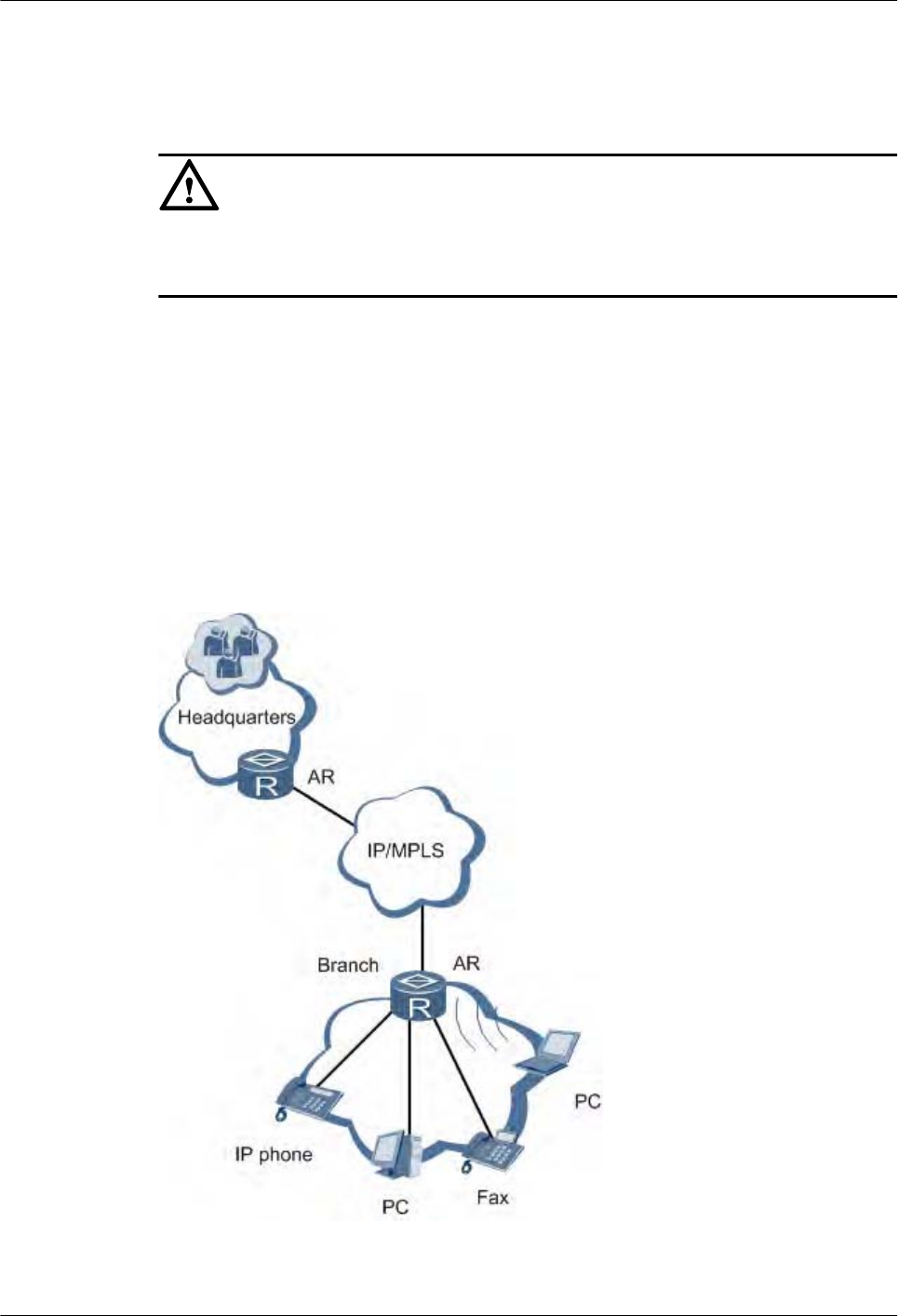
1.1 Product Positioning
CAUTION
AR G3 Series Enterprise Routers are class A products. Customers should take preventative
measures as the operating devices may cause radio interference.
AR series enterprise routers (ARs) include AR150, AR200, AR1200, AR2200, and AR3200.
They are the next-generation routing and gateway devices, which provide the routing, switching,
wireless, voice, and security functions.
As shown in Figure 1-1, the ARs are located between an enterprise network and a public
network, functioning as the only ingress and egress for data transmitted between the two
networks. The deployment of various network services over the ARs reduces operation &
maintenance (O&M) costs as well as those associated with establishing an enterprise network.
You can select ARs of different specifications as egress gateways based on the user quantity of
an enterprise.
Figure 1-1 ARs on the network
Huawei AR G3 Series Enterprise Routers
Product Description 1 Product Position and Characteristics
Issue 02 (2012-04-20) Huawei Proprietary and Confidential
Copyright © Huawei Technologies Co., Ltd.
2

1.2 Product Characteristics
The ARs use leading hardware platforms and software architectures. The ARs provide integrated
network solutions to enterprise customers with minimum investment costs; therefore, they can
meet the many facets of future business expansion and IT industry developments.
1.2.1 Carrier-Class Reliability
lThe AR1200&2200&3200 boards are hot swappable and guarantee carrier-class reliability.
lThe ARs are designed to provide quality service and comply with telecommunication
standards.
lThe ARs protect networks against attacks.
lThe ARs support in-service patching so that the system software can be upgraded during
system operation.
lThe AR2200&3200 support redundant power supply units and fans. If one power supply
unit or fan is faulty, the AR2200&3200 will still be able to operate.
1.2.2 Service Integration Capability
The AR series routers integrate various services of routers, switches, and wireless devices,
including voice, firewall, WLAN, and VPN.
1.2.3 Hardware Extensibility
The ARs provide the highest port density in the industry and include flexible service interface
card (SIC) slots, allowing enterprise customers to connect to LAN, WAN, or wireless networks.
The ARs provide the most economical enterprise network solutions.
The ARs support flexible slot combination. For example, two SIC slots can be combined into a
wide SIC (WSIC) slot, two WSIC slots are combined into an extra SIC (XSIC) slot, and two
XSIC slots can be combined into an extended extra SIC (EXSIC) slot. In addition, a SIC card
can be installed into a WSIC slot.
NOTE
AR150&200 series do not support subcards.
1.2.4 Remote Maintenance Capability
In addition to one-stop deployment, plug and play capability, and remote commissioning
functions, the ARs manage the customer premises equipment (CPE) remotely. The remote
maintenance function improves efficiency and greatly reduces maintenance costs.
Huawei AR G3 Series Enterprise Routers
Product Description 1 Product Position and Characteristics
Issue 02 (2012-04-20) Huawei Proprietary and Confidential
Copyright © Huawei Technologies Co., Ltd.
3

2 Network Applications
About This Chapter
2.1 WAN Access
2.2 VPN Access
2.3 Enterprise Intranet Security
2.4 Voice Application
2.5 FTTx
Huawei AR G3 Series Enterprise Routers
Product Description 2 Network Applications
Issue 02 (2012-04-20) Huawei Proprietary and Confidential
Copyright © Huawei Technologies Co., Ltd.
4
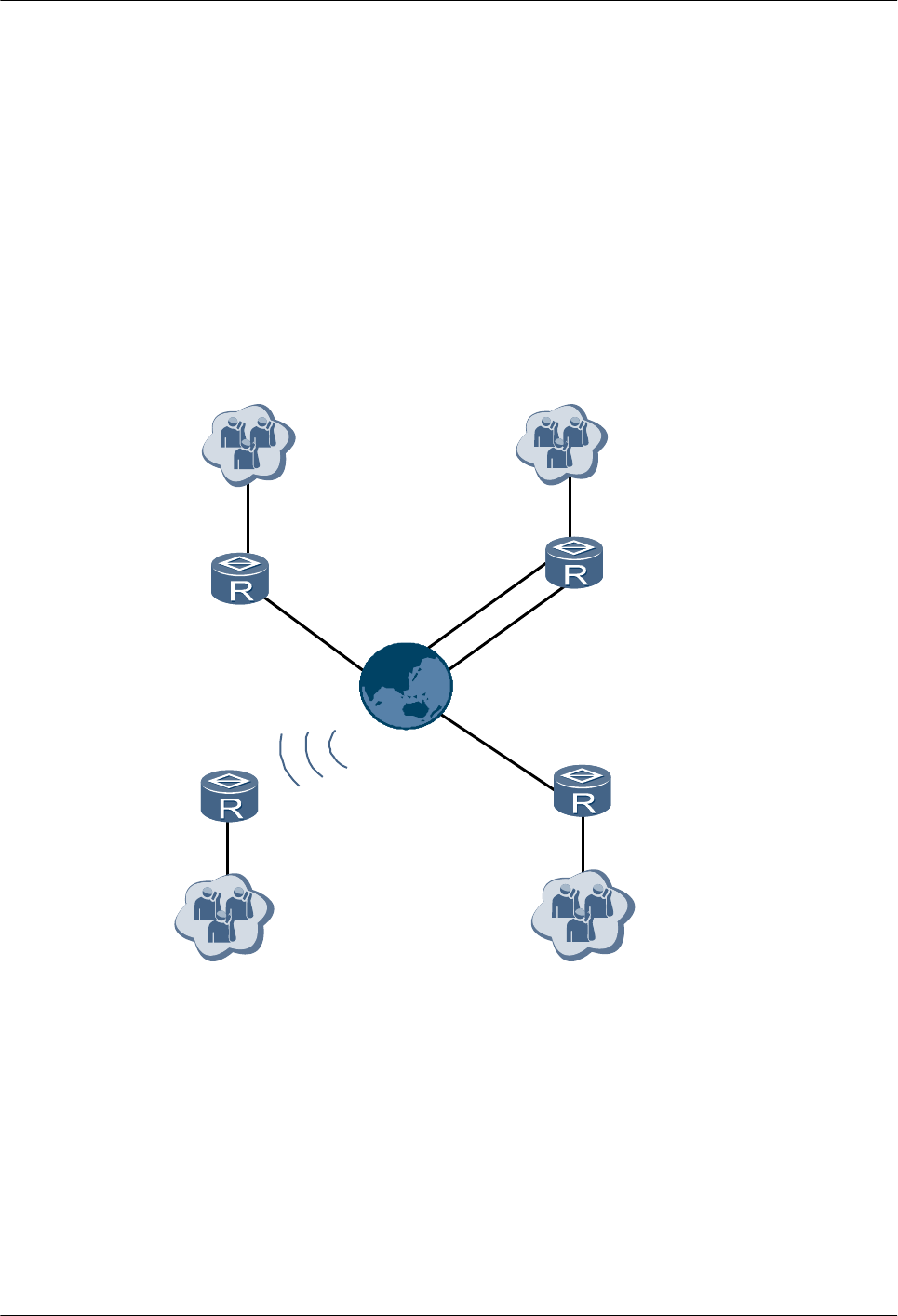
2.1 WAN Access
Depending on the network environment provided by carriers, users can access the network by
using CE1/CT1, E1/T1-F, 3G, FE/GE, ADSL, VDSL, G.SHDSL, Integrated Services Digital
Network (ISDN), CPOS, AS, xPON or SA. The ARs provide dual-uplink to ensure service
reliability. The ARs provide the following services for access users:
As shown in Figure 2-1, enterprise A accesses the Internet using ADSL; enterprise B accesses
the Internet using FE and CE1 dual-uplink; enterprise C accesses the Internet using G.SHDSL;
enterprise D accesses the Internet using 3G.
Figure 2-1 WAN access
Enterprise A
FE
Enterprise B
3G
AR
AR AR
AR
Enterprise D Enterprise C
E1/CE1
G.SHDSL
I
n
t
e
r
n
e
t
I
n
t
e
r
n
e
t
I
n
t
e
r
n
e
t
I
n
t
e
r
n
e
t
ADSL
2.2 VPN Access
The headquarters and branches use the ARs establish a VPN and connect to the Internet. The
enterprise establishes a VPN and uses GRE, MPLS, or IPSec VPN to ensure data security. The
employees on a business trip use IPSec VPN tunnels to communicate with the headquarters.
As shown in Figure 2-2, the headquarters is connected to the Internet by using the
AR2200&3200, and provides services for all employees. The LAN of the branch connects to
Huawei AR G3 Series Enterprise Routers
Product Description 2 Network Applications
Issue 02 (2012-04-20) Huawei Proprietary and Confidential
Copyright © Huawei Technologies Co., Ltd.
5
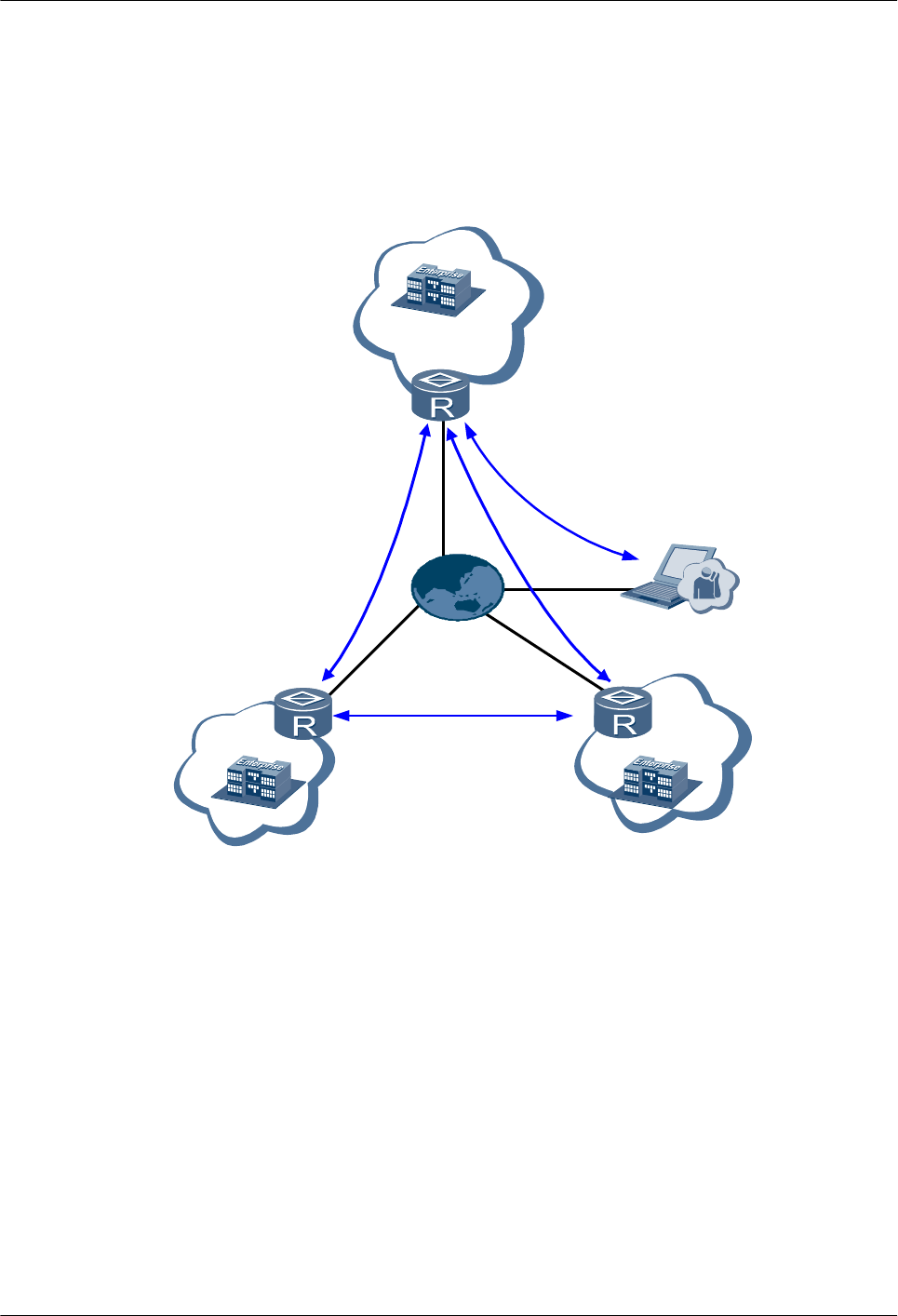
the Internet by using the AR150&200&1200&2200, so the employees in the branch can access
the headquarters network.
The headquarters and branch use GRE VPN, MPLS/BGP IP VPNor IPSec VPN tunnels to
establish an intranet. The employees on a business trip set up IPSec VPN , L2TP VPN or SSL
VPN tunnels, and access the intranet after passing authentication.
Figure 2-2 VPN access
Employee on
business trip
AR
AR
GRE/MPLS /IPSEC VPN
I
n
t
e
r
n
e
t
I
n
t
e
r
n
e
t
I
n
t
e
r
n
e
t
I
n
t
e
r
n
e
t
L2TP/SSL/IPSEC VPN
GRE/MPLS /IPSEC VPN
AR
Headquarters
Branch B
Branch A DSVPN
2.3 Enterprise Intranet Security
The ARs, located between the enterprise intranet and the Internet, ensure information security
on the entire intranet and intranet LANs.
As shown in Figure 2-3, an intranet and the Internet are connected by the ARs. The users on
the Internet cannot access the intranet. To allow the users on the intranet to access the Internet,
configure network address translation (NAT) on the intranet. The financial department and
marketing department have individual LANs on the intranet. The ARs utilize a demilitarized
zone to protect the server on the external network. In addition, the application specific packet
filter (ASPF) firewall can be deployed to protect the intranet.
The ARs provide network access control (NAC) to restrict the access permissions of internal
users. This ensures that only authorized users can access the intranet.
Huawei AR G3 Series Enterprise Routers
Product Description 2 Network Applications
Issue 02 (2012-04-20) Huawei Proprietary and Confidential
Copyright © Huawei Technologies Co., Ltd.
6
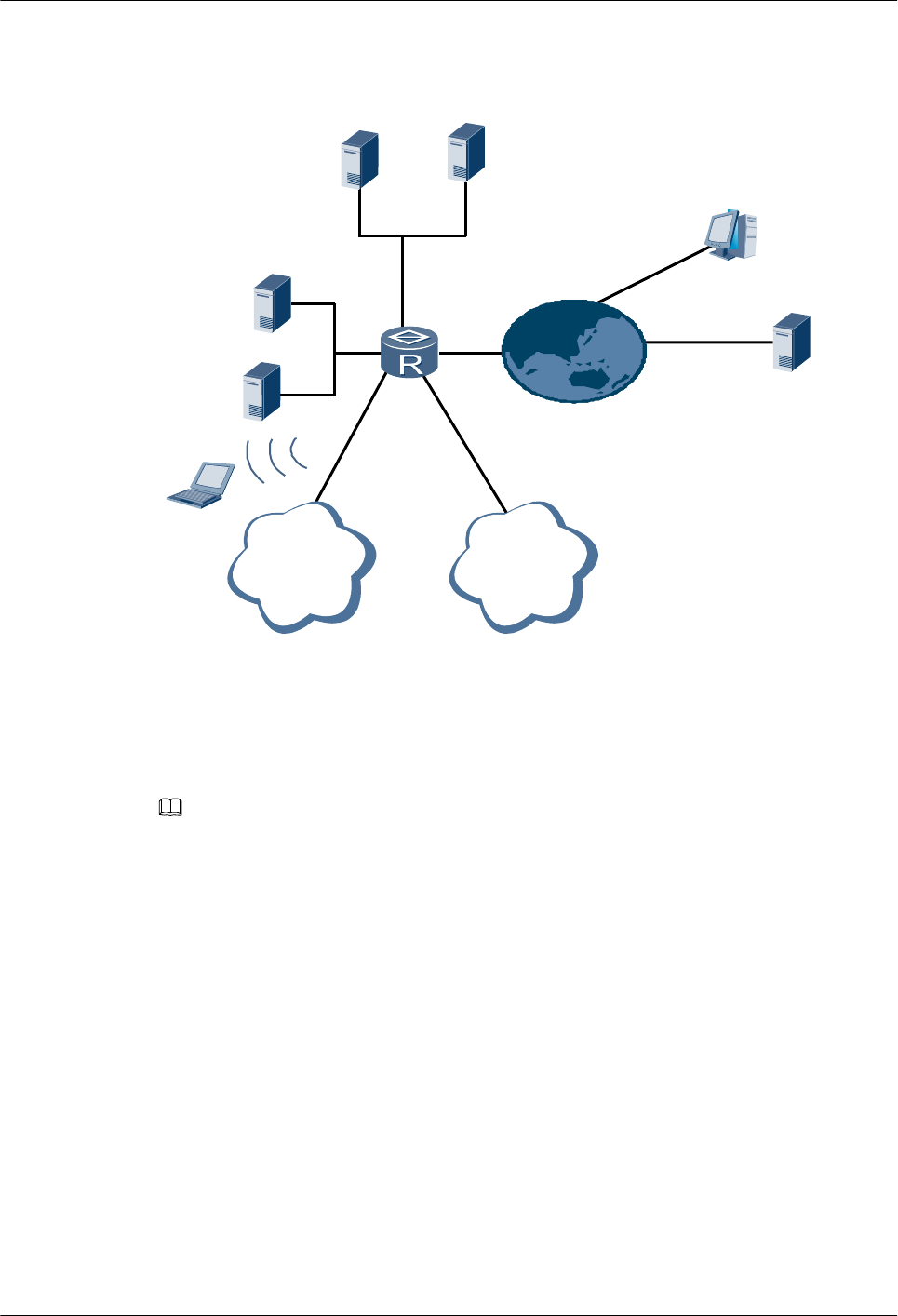
Figure 2-3 Enterprise intranet security
Marketing Financial
Public host
External
server
Internal
server
I
n
t
e
r
n
e
t
I
n
t
e
r
n
e
t
I
n
t
e
r
n
e
t
I
n
t
e
r
n
e
t
Public server
PC
Wi-Fi
AR
2.4 Voice Application
NOTE
lAmong the AR200 series routers, only the AR207Vs and AR207V-Ps support the voice features.
Among the AR1200 series routers, only the AR1220Vs and AR1220VWs support the voice features.
The AR2200 and AR3200 series routers support the voice features only after a DSP module is installed.
lTo provide voice services for POTS users on AR1200, AR2200 ,and AR3200 series routers, 4FXS/
1FXO board is required.
lTo provide voice services for ISDN users on AR1200, AR2200 ,and AR3200 series routers, 2BST
board is required.
An enterprise can build a voice communication system over the IP network, reducing operating
expenses (OPEX).
Within the voice communication system, an AR can function as an IP PBX or SIP access gateway
(AG). The AR connects to POTS users (analog phones or fax machines) and SIP user equipment
(UE) users (IP phones or PC software terminals) through FXS or Ethernet interfaces. The AR
connects to the PSTN through FXO interfaces or to the IP network through Ethernet interfaces.
Based on branch locations, the centralized or distributed call control model can be used. If all
branches within an enterprise use the same number segment, the centralized call control model
is recommended. If an enterprise has many branches that use different number segments, the
distributed call control model is recommended.
Huawei AR G3 Series Enterprise Routers
Product Description 2 Network Applications
Issue 02 (2012-04-20) Huawei Proprietary and Confidential
Copyright © Huawei Technologies Co., Ltd.
7
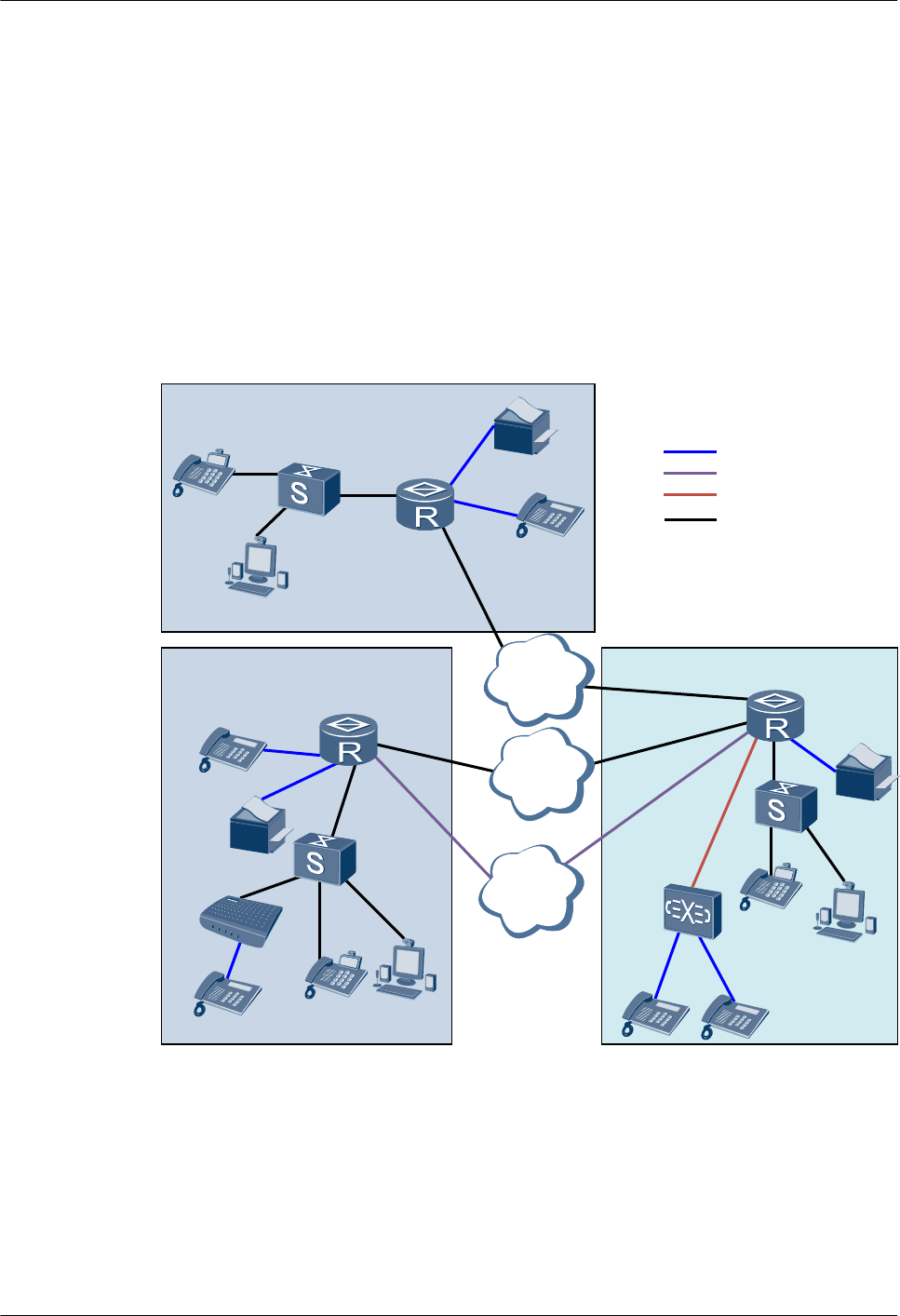
As shown in Figure 2-4, the enterprise headquarters and branch A use different number
segments. The ARs working in IP PBX mode are deployed at the enterprise headquarters and
branch A as egress routers. Voice users in the enterprise headquarters are registered with the AR
in the enterprise headquarters, and voice users in each branch are registered with the AR in the
branch. Voice traffic is transmitted between the enterprise headquarters and branches over voice
routes. The AR of the enterprise headquarters provides voice routes to branches so that users in
different branches can call each other.
Branch B and the enterprise headquarters are connected through the MAN. An AR working in
IP PBX mode is deployed at the enterprise headquarters and an AR working in SIP AG mode
is deployed at branch B. All voice users at the enterprise headquarters and branches are registered
with the AR at the enterprise headquarters. The AR in the enterprise headquarters provides call
control services for all users in the enterprise.
Figure 2-4 Voice application
Analog phone
FAX
IP phonePC software
terminal
Analog phone
IAD
FXS
FXS
Eth
Eth
Eth
FAX
IP phone
PC
software
terminal
FXS
Eth
Eth
Eth
TDM PBX
Intranet
IPPBX
IPPBX
Branch A (distributed call
control model)
Headquarters
Analog
phone
FAX
IP phone
PC software terminal
FXS
E1
Eth
Eth
SIP AG
Branch B (centralized call control model)
FXS
Eth
PSTN
IMS/IP Eth
Eth
FXS interface
FXO interface
E1 interface
Ethernet interface
Eth
FXS
Eth
Eth
FXS FXS
FXO FXO
E1
2.5 FTTx
By working with the optical line terminal (OLT), the ARs function as optical network unit (ONU)
to provide fiber access to the enterprise. As shown in Figure 2-5, the ARs are connected to
upstream devices through a passive optical network (PON), and provide fiber-to-the-home,
fiber-to-the-building, and fiber-to-the-enterprise services.
Huawei AR G3 Series Enterprise Routers
Product Description 2 Network Applications
Issue 02 (2012-04-20) Huawei Proprietary and Confidential
Copyright © Huawei Technologies Co., Ltd.
8
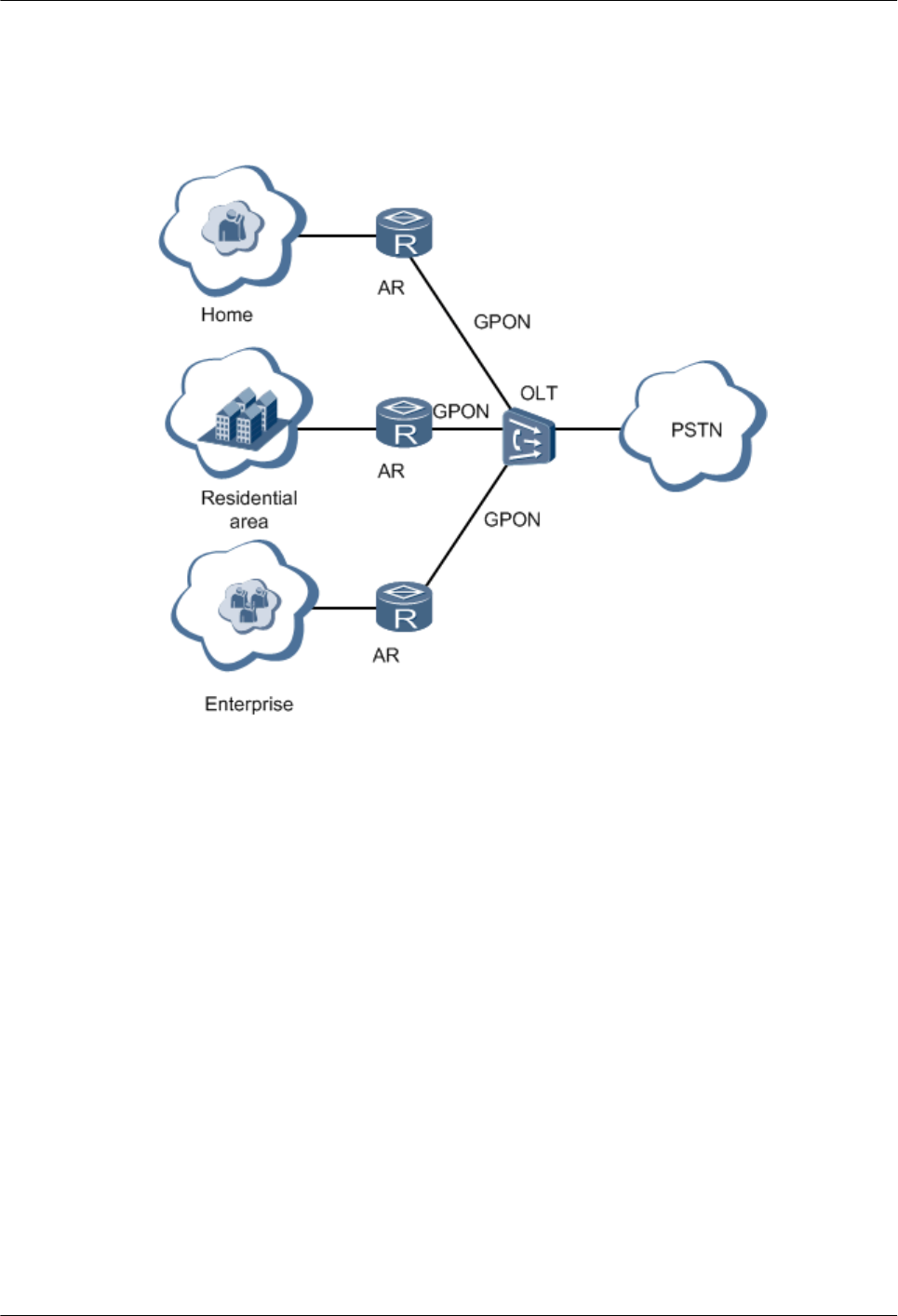
The ARs provide the fiber-to-the-x (FTTx) service by connecting to upstream PON devices.
This provides higher bandwidth than twisted-pair cable and guarantees the development of future
high-speed services.
Figure 2-5 FTTx
Huawei AR G3 Series Enterprise Routers
Product Description 2 Network Applications
Issue 02 (2012-04-20) Huawei Proprietary and Confidential
Copyright © Huawei Technologies Co., Ltd.
9

3.1 Feature List
Table 3-1 Features supported by the AR
Feature Sub-
feature
Description Difference
LAN VLAN VLAN services including
basic VLAN, super VLAN,
MUX VLAN, voice VLAN,
and guest VLAN; dynamic
VLAN learning using
Generic Attribute
Registration Protocol
(GVRP)
Only the AR2200 and AR3200
series support MUX VLAN.
MAC Dynamic and static MAC
address learning; MAC
address learning limit,
blackhole MAC entries,
sticky MAC entries, and anti-
MAC flapping
None
STP Spanning Tree Protocol
(STP), Rapid Spanning Tree
Protocol (RSTP), and
Multiple Spanning Tree
Protocol (MSTP); STP
security
None
Link
aggregation
Static link aggregation and
Link Aggregation Control
Protocol (LACP)-based
aggregation
None
LLDP Neighboring device
discovery
None
WLAN Wireless access to LANs Only the AR1220W and
AR1220VW support WLAN
features.
Huawei AR G3 Series Enterprise Routers
Product Description 3 Product Characteristics
Issue 02 (2012-04-20) Huawei Proprietary and Confidential
Copyright © Huawei Technologies Co., Ltd.
11

Feature Sub-
feature
Description Difference
WAN WAN
interface
WAN interfaces: CE1/CT1
PRI interfaces, E1/T1-F
interfaces, 3G interfaces,
CPOS interfaces, FE/GE
interfaces, ADSL interfaces,
VDSL interface, G.SHDSL
interfaces, ISDN BRI
interfaces, synchronous and
asynchronous serial
interfaces, and PON
interfaces
WAN interfaces depend on the
device model and the boards
installed.
Interface
backup
Various WAN interface
backup mechanisms, and
association between interface
backup and NQA, BFD, and
routes
None
Link layer
protocol
Link layer protocols such as
Point-to-Point Protocol/
Multilink Protocol (PPP/
MLPPP), Frame Relay/
Multilink Frame Relay (FR/
MFR), High-Level Data Link
Control (HDLC), and ATM,
and Operation,
Administration, and
Maintenance (OAM)
mechanisms complying with
link layer protocols
FR compression and FR over
IP
Access of PPPoE IPv4 or
IPv6 host and PPPoE dial-up
On the AR150 and AR200, the
link layer protocol cannot be FR,
MFR, or HDLC.
Dialing Dial control center (DCC)
function and logical
interfaces that transmit the
dialing service
None
PON EPON and GPON working
modes, and connection with
an OLT
The AR150 series and AR200
series do not support PON.
Network
bridge
Bridge between Ethernet
interfaces and WAN
interfaces
None
Huawei AR G3 Series Enterprise Routers
Product Description 3 Product Characteristics
Issue 02 (2012-04-20) Huawei Proprietary and Confidential
Copyright © Huawei Technologies Co., Ltd.
12

Feature Sub-
feature
Description Difference
3G 3G uplink, allowing access to
3G networks using the DCC
function (the AR provides the
3G data card and 3G SIC
card)
The AR150 series and AR200
series do not support the 3G data
card or 3G SIC card. Only
specified 3G models support 3G
uplink.
Voice Line
configuratio
n
Foreign exchange station
(FXS), foreign exchange
office (FXO), VE1, and
ISDN line access and
configuration
Only the AR207V, AR207V-P,
AR1220V, AR1220VW,
AR2200 series, and AR3200
series support voice features.
SIP AG The upper-layer device such
as soft switch performs call
control and management. The
AR communicates with the
soft switch by using the SIP
protocol.
The AR provides the Branch
Exchange for Survivable
Telephony (BEST) function.
PBX The AR provides FXS, FXO,
VE1, and ISDN interfaces,
and supports R2 signaling,
H323 signaling, media proxy,
multi-party conference,
blacklist, and DISA service.
IP
applicatio
n
ARP Address resolution for
Ethernet
None
IPv4/IPv6
host
IPv4 and Ipv6 address
management, TCP/UDP
socket, ICMP, ping and
tracert, and UDP helper
None
DNS DNS client, DNS proxy, and
dynamic DNS (DDNS) client
None
DHCP DHCP client(v4/v6), DHCP
relay, and DHCP server, and
DHCP security
None
NetStream Fixed packet sampling and
packet statistics collection,
with flow output in V5, V8 or
V9 format
None
Huawei AR G3 Series Enterprise Routers
Product Description 3 Product Characteristics
Issue 02 (2012-04-20) Huawei Proprietary and Confidential
Copyright © Huawei Technologies Co., Ltd.
13

Feature Sub-
feature
Description Difference
NAT NAT, port address translation
(PAT), port application
mapping (PAM), Easy NAT,
and NAT server, providing
application layer gateways
(ALG) for each application
None
VRRP Redundancy backup
mechanism for IP services
None
BFD Single-hop BFD, multi-hop
BFD, BFD for VRRP, and
BFD for routing protocols
None
Network
Quality
Analysis
(NQA)
Detecting the performance of
protocols running on the
network
None
IP routing IPv4 and
IPv6 Static
route
Basic routing functions None
RIP and
RIPng
Routing protocol None
OSPFv2 and
OSPFv3
Routing protocol None
ISIS and
ISISv6
Routing protocol None
BGP and
BGP4+
Routing protocol None
Routing
policy
Basic routing functions and
intelligent PBR
None
Multicast IGMP Basic IGMP functions
including IGMP snooping
Only the AR2200 series and
AR3200 series support IGMP
snooping.
Multicast
routing
Multicast route management,
multicast route load
balancing, and source-
specific multicast (SSM)
mapping
None
PIM (IPv4) PIM-DM and PIM-SM None
MSDP Inter-domain (PIM-SM
domain) multicast routing
None
QoS MQC Modular traffic classification None
Huawei AR G3 Series Enterprise Routers
Product Description 3 Product Characteristics
Issue 02 (2012-04-20) Huawei Proprietary and Confidential
Copyright © Huawei Technologies Co., Ltd.
14

Feature Sub-
feature
Description Difference
Priority
mapping
Mapping between local
priorities, 802.1p priorities,
DSCP priorities, and EXP
priorities
None
Traffic
policing
Single-rate-two-bucket and
two-rate-two bucket policy
based on traffic classifiers,
permanent virtual circuits
(PVCs)/VLANs/data link
connection identifiers
(DLCIs), and interfaces
None
Traffic
shaping
Traffic shaping based on
traffic classifiers, PVCs/
VLANs/DLCIs, and ports,
traffic shaping adaptation,
and three-level traffic
shaping
None
Congestion
management
Congestion management
based on traffic classifiers,
PVCs/VLANs/DLCIs, and
ports; queue mechanisms
including PQ, WRR, DRR,
WFQ, PQ+WRR/PQ+DRR/
PQ+WFQ, and CBQ
None
Congestion
avoidance
Priority-based weighted
random early detection
(WRED) and tail drop
None
HQoS Hierarchical Quality of
Service (HQoS) implements
hierarchical scheduling based
on queues and differentiates
services and users.
None
Smart
Application
Control
(SAC)
SAC uses the deep packet
inspection (DPI) technology
to identify packets of
dynamic protocols such as
HTTP, FTP, and RTP by
checking Layer 4 to Layer 7
information in the packets.
SAC helps implement refined
QoS management.
None
Security AAA AAA for administrators and
access users, including local,
RADIUS, and TACACS
AAA
None
Huawei AR G3 Series Enterprise Routers
Product Description 3 Product Characteristics
Issue 02 (2012-04-20) Huawei Proprietary and Confidential
Copyright © Huawei Technologies Co., Ltd.
15

Feature Sub-
feature
Description Difference
Firewall DMZ firewall, packet
filtering firewall, and stateful
firewall; blacklist and
whitelist, and attack detection
None
Traffic
suppression
Traffic suppression based on
ports
None
Access
security
802.1x authentication, MAC
address authentication, MAC
address bypass
authentication, and direct
MAC address authentication
based on users and ports; web
authentication and guest
VLAN for access users
None
Local attack
defense
Device protection measures,
including CPU attack defense
and attack source tracing.
None
ARP
security
Suppression of ARP packets
from the user side and
network side, ARP anti-
spoofing, ARP gateway
attack inspection, and
dynamic ARP inspection
(DAI)
Only the AR2200 series and
AR3200 series support DAI.
IP security ICMP anti-attack, URPF, IP
source guard and DHCP
snooping
Only the AR2200 series and
AR3200 series support IP source
guard and DHCP snooping.
PKI Certificate request, update,
and verification
None
HTTPS HTTPS server function,
ensuring transmission
security between users and
devices using SSL features
such as data encryption and
identity verification
None
ACL Traffic classification based
on physical ports, Layer 2
information, IP protocols,
and TCP/UDP ports.
None
Huawei AR G3 Series Enterprise Routers
Product Description 3 Product Characteristics
Issue 02 (2012-04-20) Huawei Proprietary and Confidential
Copyright © Huawei Technologies Co., Ltd.
16

Feature Sub-
feature
Description Difference
VPN IPSec VPN Interconnecting headquarters
and branches using IKE V1/
V2 IPSec tunnels; hardware-
based MD5 and SHA
algorithms; AES, DES, and
3DES algorithms
None
SSL VPN Virtual gateway, front-door
VPN function, and
management of SSL VPN
users and SSL VPN services
None
DSVPN Dynamic setup of a data
forwarding channel between
hubs
None
L2TP Functioning as the LAC or
LNS and allowing concurrent
user access on multiple
channels
None
GRE VPN GRE tunnel for
interconnecting the
headquarters and branches
Used together with IPSec.
IPSec cannot protect
multicast data, but GRE VPN
can protect multicast data
None
Device
managem
ent
Information
center
monitoring
Managing boards, power
supply units, fans, and e-
labels
None
Version
management
In-service upgrade, rollback,
and patch installation
None
Mirroring Port- and flow-based
mirroring
None
Remote PoE
power
supply
LAN-side remote power
supply
Only the AR207V-P, AR1220V,
AR1220W and AR1220VW
support the PoE features.
Web-based
network
management
system
Internal web management
system, providing GUI to
manage and maintain devices
None
Huawei AR G3 Series Enterprise Routers
Product Description 3 Product Characteristics
Issue 02 (2012-04-20) Huawei Proprietary and Confidential
Copyright © Huawei Technologies Co., Ltd.
17

Feature Sub-
feature
Description Difference
Deployment Automatic deployment using
a universal serial bus (USB)
flash drive; Auto-Config
function for the entire
network
None
Network
managem
ent
SNMP SNMP agent, fault
management (FM), and trap
switch control (TSC)
None
Ping and
Tracert
Network connectivity
detection
None
NTP Time synchronization for
traditional IP networks
None
RMON Monitoring and traffic
statistics for traffic on a
network segment
None
CWMP CWMP (TR-069) for
remotely managing AR
devices
None
MPLS Basic MPLS
functions
Static label switched path
(LSP) and penultimate hop
popping (PHP); MPLS LSP
QoS
AR200 series routers do not
support MPLS.
MPLS LDP MPLS LDP
L3VPN BGP L3VPN
MPLS TE MPLS TE
MPLS FRR LDP FRR, TE FRR, and VPN
FRR
3.2 Key Features
3.2.1 Voice
In addition to broadband services, such as video on demand (VOD) and live data and video, the
AR provides high-quality voice service for terminal users.
Huawei AR G3 Series Enterprise Routers
Product Description 3 Product Characteristics
Issue 02 (2012-04-20) Huawei Proprietary and Confidential
Copyright © Huawei Technologies Co., Ltd.
18

NOTE
lAmong the AR200 series routers, only the AR207Vs and AR207V-Ps support the voice features.
Among the AR1200 series routers, only the AR1220Vs and AR1220VWs support the voice features.
The AR2200 and AR3200 series routers support the voice features only after a DSP module is installed.
lTo provide voice services for POTS users on AR1200, AR2200 ,and AR3200 series routers, 4FXS/
1FXO board is required.
lTo provide voice services for ISDN users on AR1200, AR2200 ,and AR3200 series routers, 2BST
board is required.
SIP AG
Access gateway (AG) devices provide various access modes and convert various services into
a uniform format that can be transmitted. The AG communicates with the soft switch by using
the SIP protocol. SIP-based AGs are called SIP AGs.
When an AR functions as the SIP AG, the upper-layer devices such as soft switch control and
manage calls. The AR supports the following services.
Table 3-2 Services Supported by a SIP AG
Service Type Description
Basic voice service The basic voice service provides call connections, including intra-
office calls, local calls, national long-distance calls, international
long-distance calls, and transit calls.
Three-party service The third-party service allows a calling party or called party in a
conversation to call a third party without ending the current
conversation. Then the calling party or original called party can
make a three-party conversation or talk to the other two parties
separately.
Call waiting service If user C calls user A when user A is talking with user B, user A
hears a call waiting tone indicating that there is an incoming call.
MWI service The message waiting indicator (MWI) service allows a user to
read unread or leave messages. When the called user is busy, the
MWI is on indicating that there are messages.
Malicious call
identification (MCID)
service
The MCID service allows users to perform certain operations to
find the phone number of an attacker that initiates malicious calls.
Call transfer service The call transfer service allows the called party to transfer an
incoming call to a third party by pressing the hookflash so that the
calling party establishes a connection with a new called party.
Call conference service The call conference service allows more than three parties to talk
to each other.
Calling line
identification
presentation (CLIP)
service
The CLIP service displays the calling number in onhook state or
offhook state (for call waiting). The displayed information
includes the phone number, name, date, and time.
Huawei AR G3 Series Enterprise Routers
Product Description 3 Product Characteristics
Issue 02 (2012-04-20) Huawei Proprietary and Confidential
Copyright © Huawei Technologies Co., Ltd.
19

Service Type Description
Calling line
identification restriction
(CLIR) service
The CLIR service shields the calling number on the terminal of a
called party.
Distinctive ringing
service
The distinctive ringing service plays different ring tones for
incoming calls from different calling parties.
Differentiated ringback
tone service
The differentiated ringback tone service plays different ringback
tones for different users.
Advice of charge (AoC)
service
The AoC service displays the charge rate, fee notification during
a call, and total fee of the call.
Polarity reversal
charging service
The polarity reversal charging service notifies the accounting
terminal of the accounting starting point and stop point using
polarity reversal when users are in a conversation or end the
conversation.
Polarity reversal pulse
charging service
The polarity reversal pulse charging service generates a polarity
reversal pulse on an interface to notify the accounting terminal of
the accounting starting point and stop point during a conversation
or when the conversation ends.
Urgent call process If the SIP AG detects an urgent call, it inserts an urgent call flag
into the SIP message.
Completion of Calls to
Busy Subscriber (CCBS)
service
The CCBS service enables the SIP AG to monitor the called party
status when the called party is busy. When the called party is idle,
the SIP AG notifies the calling party so that the calling party can
determine whether to make a call to the called party again.
Multiple MSN numbers
on a POTS interface
Multiple MSN numbers can be configured on a POTS interface.
Hotline service lInstant hotline service: After a user picks up a phone, the SIP
AG dials the hotline number for the user.
lNo dialing within a long time after picking up the phone: If a
user does not dial any number within the specified period of
time after picking up a phone, the SIP AG dials the hotline
number for the user.
Anonymous call service The anonymous call service disables the called party from viewing
information about incoming calls.
BEST When the primary channel between the branch and headquarters
is faulty, enable the Branch Exchange for Survivable Telephony
(BEST) function in the branch to implement communication in
the branch and between the branch and the headquarters over the
PSTN.
Huawei AR G3 Series Enterprise Routers
Product Description 3 Product Characteristics
Issue 02 (2012-04-20) Huawei Proprietary and Confidential
Copyright © Huawei Technologies Co., Ltd.
20

PBX
PBXs are widely used in enterprises. They manage incoming and outgoing calls of enterprises.
The AR as a PBX supports the following individual and group services.
Table 3-3 Individual Service supported by a PBX
Service Type Description
Abbreviated dialing Allows a user to dial an abbreviated code of
one or two digits instead of the original called
number.
Outgoing call barring Restricts call-out permissions of some
phones. For example, the outgoing call
barring service can prevent a phone from
making long-distance calls.
Call forwarding Allows a called user to transfer a call to a
specified third party if the called user has
activated the call forwarding service and the
call meets the call forwarding conditions.
Number barring Prevents a user from dialing a specified
number.
Do-not-disturb Rejects calls to a user. When other users call
a user that has subscribed to the do-not-
disturb service, they hear a do-not-disturb
tone or busy tone.
Reject anonymous call Allows a user to reject a call when the calling
number is not displayed and plays a voice
prompt to the calling user.
Remote office Allows a user to access the office telephone
network from any terminal and use original
services such as abbreviated dialing and call
transfer.
Secretary Allows a user to designate another phone
number (for example, the secretary's phone
number) to process all incoming calls. That
is, all incoming calls of the user are
transferred to the secretary's phone number
first, and only the secretary can call the user
directly.
Wake-up service Allows a phone to ring automatically at the
preset time.
Personal ring back tone (RBT) Uses user-defined music or sound effects to
replace the common ringback tone, and plays
the music or sound effects to calling users.
Huawei AR G3 Series Enterprise Routers
Product Description 3 Product Characteristics
Issue 02 (2012-04-20) Huawei Proprietary and Confidential
Copyright © Huawei Technologies Co., Ltd.
21

Service Type Description
Selective call rejection Filters every incoming call against a list of
rejected calling numbers created by a user and
rejects calls made by numbers on the list.
Selective call acceptance Filters every incoming call against a list of
calling numbers created by a user and accepts
calls from only the numbers on the list.
Table 3-4 Group Services supported by a PBX
Service Type Description
Call interception Provides a voice prompt when a call fails to
be connected. The user can learn about the
failure cause and determine whether to redial
the called number according to the voice
prompt.
Distinctive ringing Plays different ring tones to users based on
the prefix analysis result (local calls, national
calls, international calls, and intra-Centrex
calls).
Enterprise RBT Uses music or sound effects made by an
enterprise to replace the common ringback
tone, and plays the music or sound effects to
calling users.
Interactive voice response (IVR) Provides the automated attendant function
and allows enterprises to make their own IVR
menus and voice prompts, improving user
experience.
Number change Hides calling numbers or displays the same
calling number for all outgoing calls.
Pre-routing number change Provides various dialing modes and changes
the calling number displayed on the called
party's phone.
Post-routing number change Provides various dialing modes and changes
the calling number displayed on the called
party's phone. A post-routing number change
plan can change a called number to a long
number to ensure that it complies with the
required number format.
PBX line selection When a calling party dials the access number
of a PBX group, the system uses the
configured line selection mode to connect the
call to a user in the group.
Huawei AR G3 Series Enterprise Routers
Product Description 3 Product Characteristics
Issue 02 (2012-04-20) Huawei Proprietary and Confidential
Copyright © Huawei Technologies Co., Ltd.
22

Service Type Description
Co-group pickup Allows users in the same group to answer
calls for each other on their own phones. For
example, when the phone of user A rings, user
B in the same group can dial the service
access code plus user A's phone number to
answer the call.
Simultaneous ringing When a calling party dials the access number
of a simultaneous ringing group, all member
phones in the group ring simultaneously, and
the called party can answer the call using any
ringing phone.
Sequential ringing When a calling party dials the access number
of a sequential ringing group, member phones
in the group ring in the configured sequence.
One number link you (ONLY) When the calling party calls ONLY number
of the called party, multiple terminals of the
called party ring according to the configured
rules, and the called party can select one
terminal to answer the incoming call.
For details about voice features, see Feature Description - Voice.
3.2.2 WAN
WAN uses the interfaces such as Ethernet, E1, T1, ADSL, VDSL, G.SHDSL, CPOS, 3G, and
synchronous/asynchronous serial interfaces. The physical links on these interfaces can run the
FR, PPP, and HDLC protocols.
Frame Relay
Working at the data link layer of the Open System Interconnection (OSI) model, Frame Relay
(FR) uses simple methods to transmit and exchange data. On a frame relay (FR) network, virtual
circuits connect two FR devices. A physical line on the FR network provides multiple VCs. A
VC defines an FR channel by using the data link connection identifier (DLCI), and detects and
maintains the VC status by using the local management interface (LMI).
Multilink frame relay (MFR) is a cost-effective solution provided for FR users. MFR (FRF.16)
implements the multilink frame relay function on the user-to-network interfaces (UNIs).
The FR compression technologies compress FR packets to save network bandwidth, reduce
network load, and improve data forwarding on the FR network. The AR supports FRF.9 (FRF.
9 stac) and FRF.20 (FRF.20 IPHC).
PPP
The point-to-point protocol (PPP) is used at the data link layer of the OSI model as well as at
the link layer of TCP/IP. PPP transmits data from one point to another through synchronous
links and asynchronous links that support full duplex.
Huawei AR G3 Series Enterprise Routers
Product Description 3 Product Characteristics
Issue 02 (2012-04-20) Huawei Proprietary and Confidential
Copyright © Huawei Technologies Co., Ltd.
23

PPP provides a complete authentication mechanism. To set up a PPP connection, users must
pass authentication, ensuring a secured connection.
Multilink PPP (MP) is a technique that bundles multiple PPP links together to increase
bandwidth. It can be applied to the interfaces that support PPP, such as serial interfaces and low-
speed Packet over SDH (POS) interfaces.
PPPoE
A Point-to-Point Protocol over Ethernet (PPPoE) network consists of an Ethernet containing
many hosts. It accesses the Internet through a remote access device.
An AR can create a PPP session with the remote end by using PPPoE, and implement access
control and accounting.
An AR can function as the PPPoE server to connect to different types of PPPoE clients on the
Ethernet or function as a dial-up PPPoE client.
ATM
ATM is connection-oriented. Each VC is identified by a Virtual Path Identifier (VPI) and a
Virtual Channel Identifier (VCI). One pair of VPI/VCI values is useful only on a link segment
between ATM nodes. If a connection is broken, the relevant VPI/VCI values are released.
The Asymmetric Digital Subscriber Line (ADSL) , VDSL and G.Single-pair High Speed Digital
Subscriber Line (G.SHDSL) interfaces of the ARs support the Asynchronous Transfer Mode
(ATM).
HDLC
The High-level Data Link Control (HDLC) is a typical bit-oriented synchronization data control
protocol. It adopts the full-duplex mode and CRC check. Its transmission control function is
independent of the processing function, and it features control capabilities and can be flexibly
used.
In HDLC, Keepalive packets are used to detect the link status. On the AR, you can set the interval
for sending Keepalive packets by setting the polling interval.
ISDN
The ISDN protocol references the Open Systems Interconnection (OSI) model and implements
functions of the physical layer, data link layer, and network layer on UNI interfaces.
ISDN physical interfaces are classified into ISDN BRI and ISDN PRI interfaces.When the AR
accesses an ISDN network by using an ISDN PRI interface, the AR is directly connected to an
ISDN network-side device. When the AR accesses an ISDN network by using an ISDN BRI
interface, the AR connects to an NT1 device, and the NT1 device connects to an ISDN network-
side device.
For details about WAN features, see Feature Description - WAN.
3.2.3 VPN
The ARs provide an IP security (IPSec) mechanism to ensure high quality, interoperable, and
cryptology-based security for communication processes. The two parties in communication can
Huawei AR G3 Series Enterprise Routers
Product Description 3 Product Characteristics
Issue 02 (2012-04-20) Huawei Proprietary and Confidential
Copyright © Huawei Technologies Co., Ltd.
24

encrypt data and authenticate the data source at the IP layer to ensure the confidentiality and
integrity of the data and prevent replay on the network.
IPSec implements these functions by using two security protocols: Authentication Header (AH)
protocol and Encapsulating Security Payload (ESP). Internet Key Exchange (IKE) provides the
automatic key negotiation, SA establishment, and SA maintenance functions to simplify IPSec
use and management.
The AR supports IPSec VPN and provides high reliability transmission tunnels for users. In
addition, the AR uses Generic Routing Encapsulation (GRE) and Layer 2 Tunneling Protocol
(L2TP) to support the following VPN services:
lGRE VPN
lIPSec VPN
lBGP/MPLS IP VPN
lSSL VPN
lL2TP VPN
lDSVPN
lGRE over IPSec VPN
lL2TP VPN over IPSec VPN
For details about VPN features, see Feature Description - VPN.
3.2.4 Security
ACL
An access control list (ACL) defines a series of filtering rules based on certain policy, the ACL
permits or forbids the passage of data packets.
The ARs can use ACL rules to filter packets.
Firewall
lACL-based packet filtering
ACL-based packet filtering is used to analyze the information of the packets to be
forwarded, including source/destination IP addresses, source/destination port numbers, and
IP protocol numbers. The ARs compare the packet information with the ACL rules and
determine whether to forward or discard the packets.
In addition, the ARs can filter the fragmented IP packets to prevent the non-initial fragment
attack.
lASPF
Application Specific Packet Filter (ASPF) filters packets of the application layer based on
packet status. ASPF, used for security policies, detects the session information of the
application layer protocol packets, which attempt to pass the AR and prevent the unsatisfied
packets.
lAttack defense
With the attack defense feature, the ARs can detect various network attacks and protect the
internal network against attacks.
Network attacks are classified into three types: DoS attacks, scanning and snooping attacks,
and malformed packet attacks.
Huawei AR G3 Series Enterprise Routers
Product Description 3 Product Characteristics
Issue 02 (2012-04-20) Huawei Proprietary and Confidential
Copyright © Huawei Technologies Co., Ltd.
25

–DoS attack
The DoS attack is an attack to a system by using a large number of data packets. This
prevents the system from receiving requests from authorized users or suspends the host.
DoS attacks include SYN Flood attacks and Fraggle attacks. DoS attacks are different
from other attacks because DoS attackers do not search for the ingress of a network, but
prevent authorized users from accessing resources or routers.
–Scanning and snooping attack
The scanning and snooping attack is to identify the existing systems on a network by
using ping scanning (including ICMP and TCP scanning), and then find out potential
targets. By using TCP scanning, attackers can identify the operating system and the
monitored services. By scanning and snooping, an attacker can know the service type
and security vulnerability of the system and prepare for further intrusion to the system.
–Malformed packet attack
The malformed packet attack is to send malformed packets to the system. If such an
attack occurs, the system breaks down when processing the malformed IP packets.
Malformed packet attacks include Ping of Death and Teardrop.
ARP Security
There are various ARP attacks on networks, including attacks targeting hosts and gateways,
address spoofing attacks and violent attacks, virus attacks, and malicious software attacks.
The ARs ensure ARP security by discarding untrusted ARP packets, suppressing ARP packets
by using timestamps, discarding invalid ARP packets, and performing dynamic CAR on the
packets sent to the CPU. In addition to preventing ARP protocol attacks, the ARs also prevent
ARP-based network scanning attacks.
IP Source Guard
Some attacks on networks aim at source IP addresses by accessing and using network resources
through spoofing IP addresses, stealing users' information or blocking authorized users from
accessing networks.
lThe AR2200 and AR3200 series routers support IP source guard. IPSG prevents source
address spoof attacks, so attackers cannot access network resources and authorized users'
rights are protected.
lUnicast Reverse Path Forwarding (URPF) blocks packets sent from bogus source
addresses.
Local Attack Defense
The Internet technology and size develop quickly and various network applications emerge.
Many enterprises try to boost their own development by using their networks. They are
concerned about how to protect confidential data and resources in an open network environment.
Some unconscious operations may attack network devices and degrade device performance or
even cause device failure.
A large number of packets including valid packets and malicious attack packets on a network
must be processed by devices' CPUs. The malicious attack packets affect services and may even
cause a system breakdown. In addition, excessive normal packets can also lead to high CPU
usage, which degrades the CPUs' performance and interrupts services. Therefore, protecting the
CPU is a necessary and important factor for processing services and system response.
Huawei AR G3 Series Enterprise Routers
Product Description 3 Product Characteristics
Issue 02 (2012-04-20) Huawei Proprietary and Confidential
Copyright © Huawei Technologies Co., Ltd.
26

The local attack defense and source tracing functions protect the ARs against attacks. When an
attack occurs, these functions ensure non-stop service transmission and minimize the impact of
the attack on network services.
PKI
The public key infrastructure (PKI) is a system that generates public keys and digital certificates,
and verifies identities of certificate subjects to ensure information security. PKI issues digital
certificates that bind public keys to respective user identities by means of a certificate authority
(CA).
AAA
The ARs support Authentication, Authorization, and Accounting (AAA).
lAuthentication
Verifies users' identities.
lAuthorization
Grants different rights for different users to restrict the services that can be used by users.
lAccounting
Records information about network service usage of users, including service type, start
time, and traffic volume.
For details about security features, see Feature Description - Security.
3.2.5 QoS
Traffic Policing
Traffic policing discards excess traffic to limit the traffic within a specified range and to protect
network resources as well as the carriers' interests.
The ARs use committed access rate (CAR) to perform traffic policing. They support dual-rate-
three-color markers and precise bandwidth management.
Traffic Shaping
When the rate of an interface on a downstream device is slower than that of an interface on an
upstream device or burst traffic occurs, traffic congestion may occur on the downstream device
interface. Traffic shaping can be configured on the interface of an upstream device so that
outgoing traffic is sent at even rates and congestion is avoided.
The AR supportstraffic shaping adaptation and level-3 traffic shaping. Three-level shapers
include the flow queue shaper, subscriber queue shaper, and port queue shaper.
Congestion Management
If a network transmitting both delay-sensitive and delay-insensitive services is congested
intermittently, congestion management is required. However, if a network is always congested,
bandwidth needs to be increased. Congestion management sends packet flows by using queuing
and scheduling.
An interface on AR has four or eight default queues for outgoing packets. A fixed FE interface
on AR1220 has four default queues and each of other interfaces has eight. LAN-side interfaces
Huawei AR G3 Series Enterprise Routers
Product Description 3 Product Characteristics
Issue 02 (2012-04-20) Huawei Proprietary and Confidential
Copyright © Huawei Technologies Co., Ltd.
27

support the scheduling modes of priority queuing (PQ), deficit round robin (DRR), weighted
round robin (WRR), PQ+DRR, and PQ+WRR. The AR150&200&1200 series routers do not
support the DRR mode. WAN-side interfaces support the scheduling modes of PQ, WFQ, PQ
+WFQ, and class-based WFQ (CBQ). Each scheduling algorithm schedules specific types of
traffic, and affects bandwidth allocation, delay, and jitter.
Congestion Avoidance
Congestion avoidance is a flow control mechanism. A system configured with congestion
avoidance monitors network resource usage such as queues and memory buffers. When
congestion occurs or aggravates, the system discards packets.
The ARs support tail drop and WRED.
lTail drop
When the queue length reaches the upper limit, the excess packets (buffered at the queue
tail) are discarded.
lWRED
WRED sets the upper and lower drop thresholds and the maximum drop probability for
each queue. When the queue length is smaller than the lower threshold, no packets are
discarded. When the length of the queue exceeds the upper threshold, all packets are
discarded. When the queue length is between the lower threshold and the upper threshold,
incoming packets are discarded randomly. The drop probability cannot be greater than the
maximum drop probability.
The ARs use the WRED based on queue profiles or traffic policies.
For details about QoS features, see Feature Description - QoS.
3.2.6 WLAN
NOTE
Only AR1220W and AR1220VW support WLAN.
A wireless local area network (WLAN) connects two or more computers or devices and enables
the devices to communicate by using the wireless telecommunication technology. WLAN uses
the wireless technology to implement fast Ethernet access. The primary advantage of WLAN is
that terminals, such as computers, can access a network through a wireless medium rather than
a physical cable. This facilitates network construction and allows users to move around without
interrupting communication. WLAN is more flexible than traditional wired access.
WLAN is widely used in public areas such as on campuses, business centers, and airports. The
WLAN uses cables at the backbone layer, and users access the WLAN through one or more
wireless access points (WAPs) using radio waves. The transmission distance of a WAP is tens
of meters.
IEEE 802.11 is widely used by WLANs. The AR functions as fat APs to provide the following
WLAN functions:
lWLAN user management
–Dot1X access authentication
–MAC address authentication
–Pre-share-key (PSK) authentication
–EAPOL-Key negotiation
Huawei AR G3 Series Enterprise Routers
Product Description 3 Product Characteristics
Issue 02 (2012-04-20) Huawei Proprietary and Confidential
Copyright © Huawei Technologies Co., Ltd.
28

–User access control
–AAA for WLAN users
lRadio frequency (RF) management
–Country code
–RF type
–Setting radio transmission rate
–Setting radio transmission power
–Setting radio working channels
–Monitoring and eliminating radio interference
–Configurable wireless MAC layer parameters
–Configuring and querying radio attributes
–Collecting and querying performance statistics of radio frequency interfaces
lWLAN security
–WEP Open-System link authentication and encryption
–WEP Share-Key link authentication and encryption
–WPA PSK authentication and encryption
–WPA Dot1X authentication and encryption
–WPA2 PSK authentication and encryption
–WPA2 Dot1X authentication and encryption
–WAPI authentication and encryption
–TKIP/CCMP encryption
–HMAC-MD5 algorithm
–User blacklist and whitelist
lWLAN QoS
–WMM (802.11e)
–Mapping wireless-side priority to the wired-side priority
–Bandwidth limit based on users
–Bandwidth limit based on SSIDs
For details about WLAN features, see Feature Description - WLAN.
3.2.7 IPv6
The AR1200 provides the IPv6 host function, which maximizes customers' return on investment
(ROI) and prevents repeated investment during network upgrade.
The AR supports the following IPv6 functions:
lIPv6 ND
lIPv6 PMTU
lTCP6, UDP6, RawIP6, Ping IPv6, and Tracert IPv6
lICMP6 and Socket6
lIPv6 unicast routing protocols: RIPng, OSPFv3, IS-IS, BGP, and IPv6 static route
Huawei AR G3 Series Enterprise Routers
Product Description 3 Product Characteristics
Issue 02 (2012-04-20) Huawei Proprietary and Confidential
Copyright © Huawei Technologies Co., Ltd.
29

lTFTP IPv6 client, TFTP IPv6 server, FTP IPv6 client, FTP IPv6 server, Telnet IPv6 client,
and Telnet IPv6 server
lSNMP IPv6
For details about IPv6 functions, see Feature Description - IP Service and Feature Description
- IP Routing.
Huawei AR G3 Series Enterprise Routers
Product Description 3 Product Characteristics
Issue 02 (2012-04-20) Huawei Proprietary and Confidential
Copyright © Huawei Technologies Co., Ltd.
30
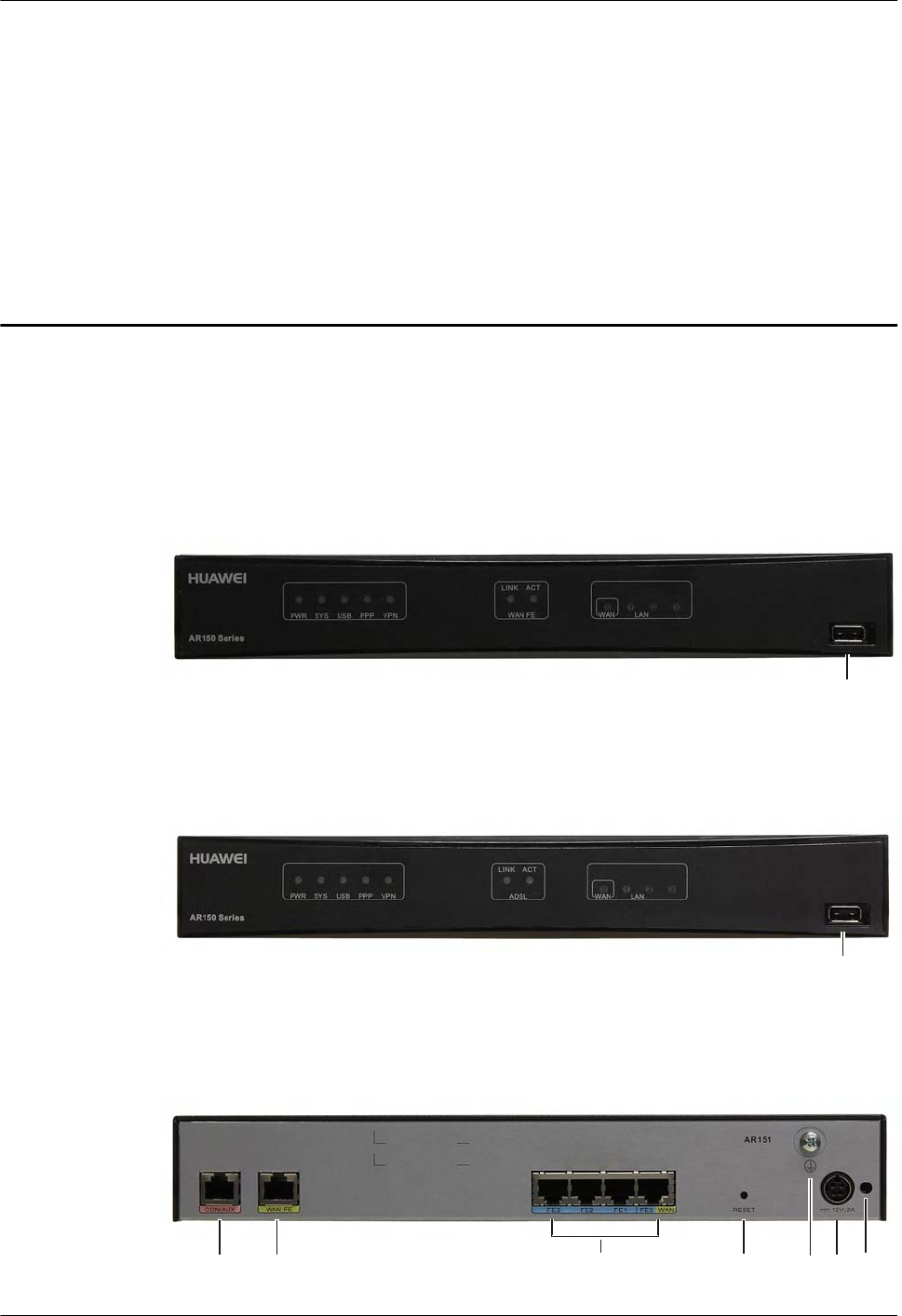
4 Device Structure of AR150 and AR200 Series
The following figures show the front view and the rear view of AR150 and AR200 series.
Front view and rear view of AR150 series
Figure 4-1 AR151 front view
8
Figure 4-2 AR157 front view
8
Figure 4-3 AR151 rear view
1 7 2 3 56
4
Huawei AR G3 Series Enterprise Routers
Product Description 4 Device Structure of AR150 and AR200 Series
Issue 02 (2012-04-20) Huawei Proprietary and Confidential
Copyright © Huawei Technologies Co., Ltd.
31
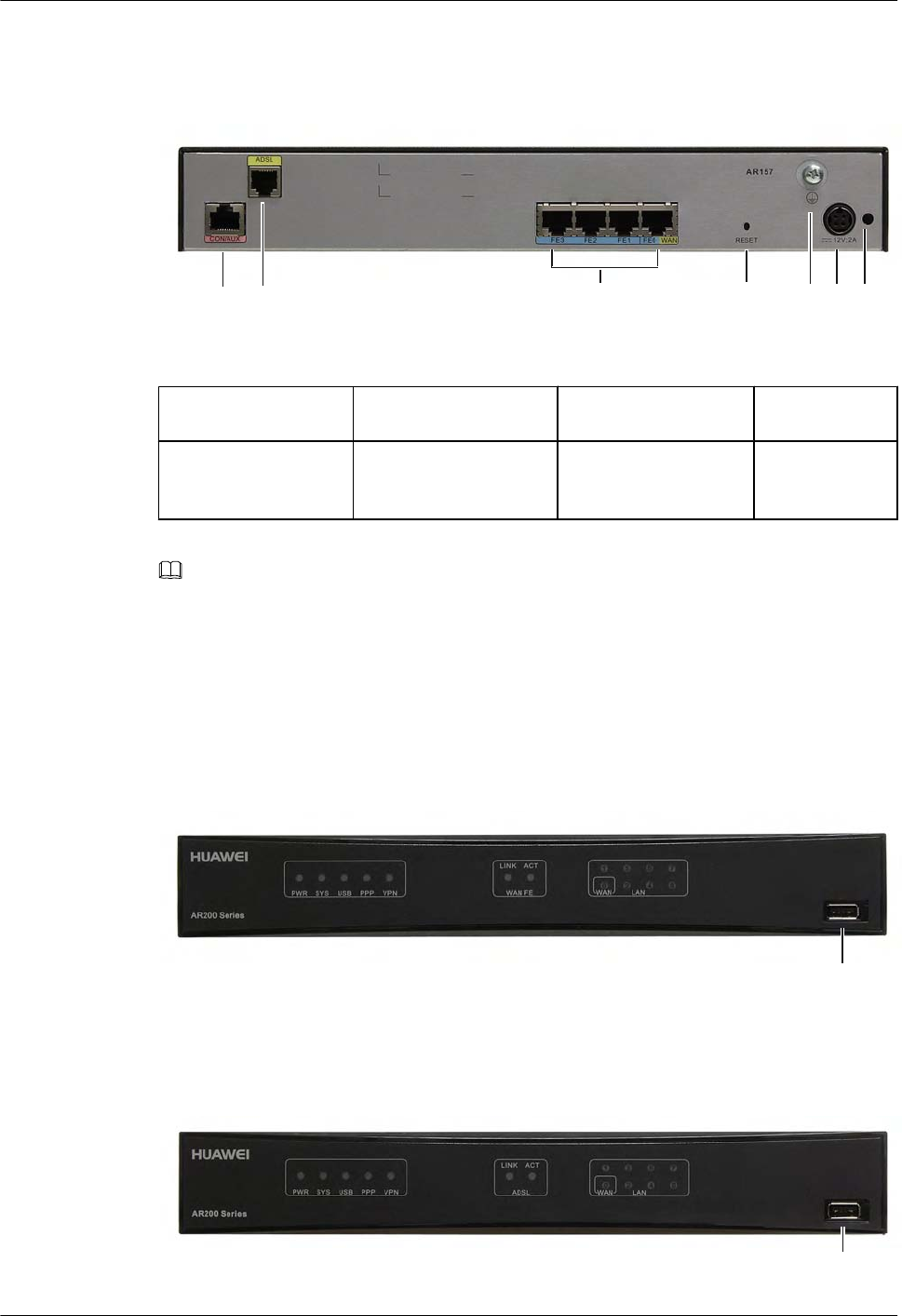
Figure 4-4 AR157 rear view
7
12356
4
1. CON/AUX interface 2. Fixed FE interfaces 3. RESET Button 4. Ground screw
5. AC jack 6. Access hole for the
power cable
7. WAN-side uplink
interface
8. USB interface
NOTE
lThe AR150 provides four LAN-side FE interfaces. The FE0 interface can be configured as a WAN-
side Layer 3 interface.
lOn the AR151, FE interfaces are WAN-side interfaces. On the AR157, ADSL ANNEX A/M interfaces
are WAN-side interfaces.
Front view and rear view of AR200 series
Figure 4-5 AR201 front view
8
Figure 4-6 AR206 front view
8
Huawei AR G3 Series Enterprise Routers
Product Description 4 Device Structure of AR150 and AR200 Series
Issue 02 (2012-04-20) Huawei Proprietary and Confidential
Copyright © Huawei Technologies Co., Ltd.
32
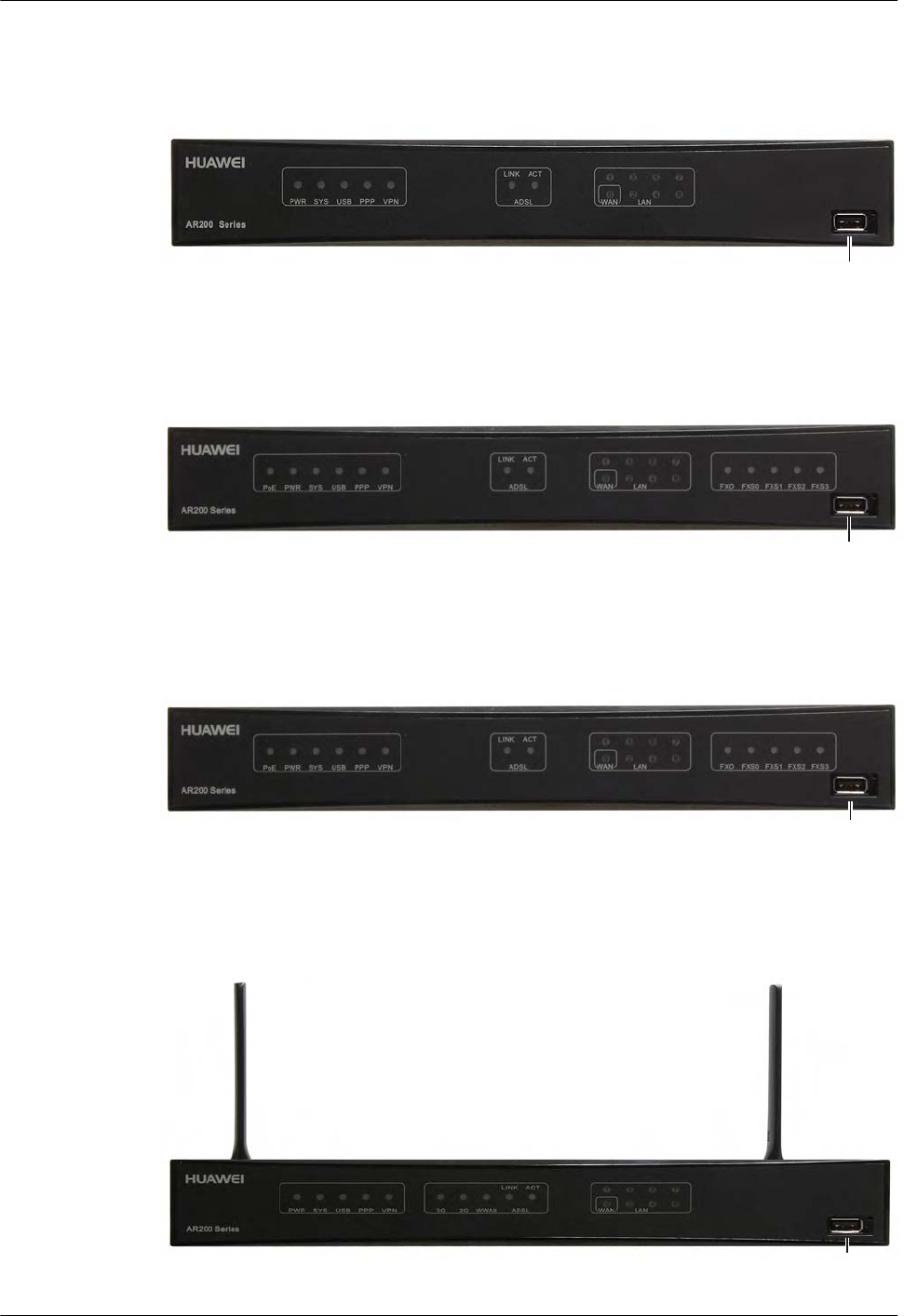
Figure 4-7 AR207 front view
8
Figure 4-8 AR207V front view
8
Figure 4-9 AR207V-P front view
8
Figure 4-10 AR207G-HSPA+7 front view
8
Huawei AR G3 Series Enterprise Routers
Product Description 4 Device Structure of AR150 and AR200 Series
Issue 02 (2012-04-20) Huawei Proprietary and Confidential
Copyright © Huawei Technologies Co., Ltd.
33
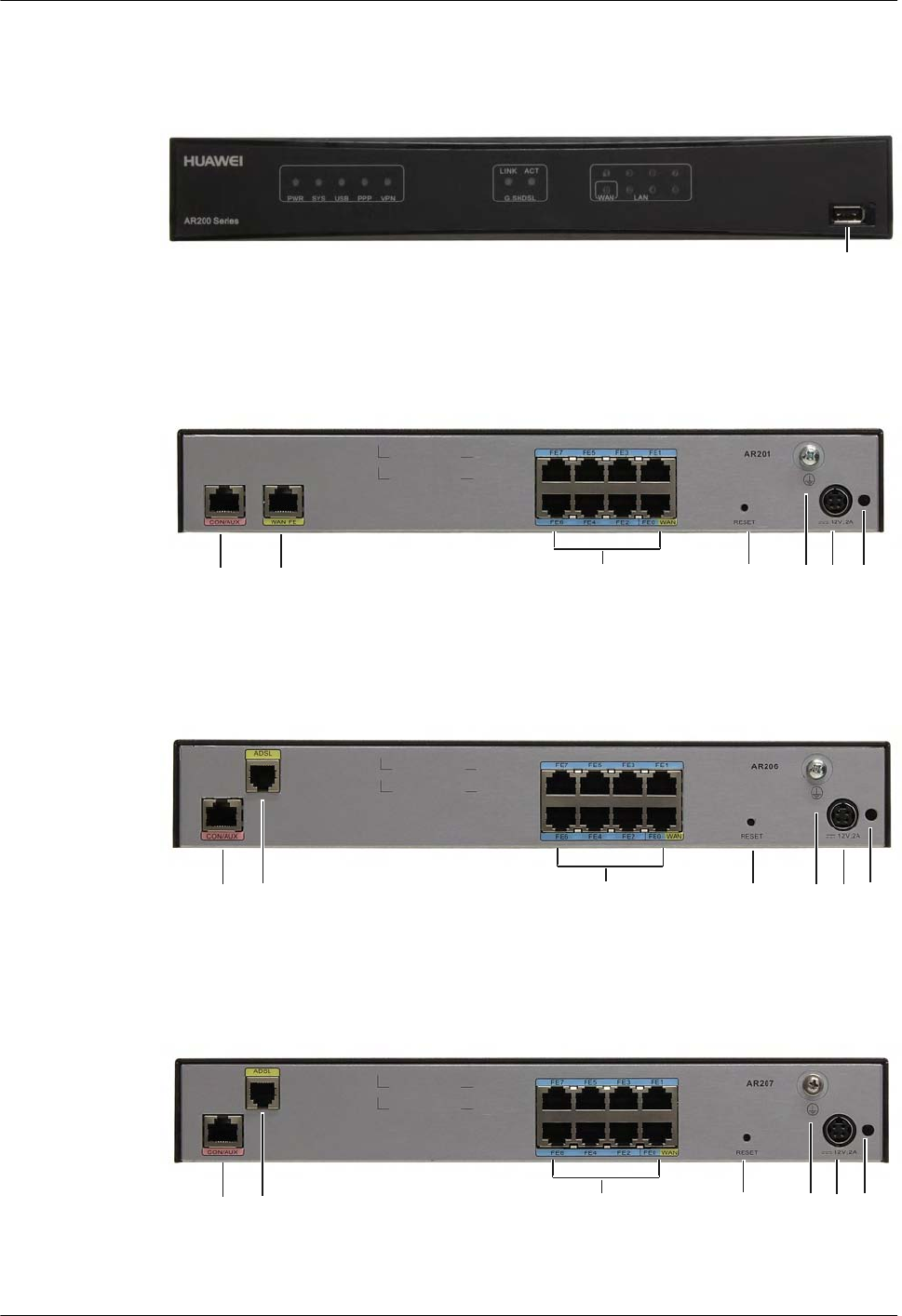
Figure 4-11 AR208E front view
8
Figure 4-12 AR201 rear view
7
12356
4
Figure 4-13 AR206 rear view
7
123 5 6
4
Figure 4-14 AR207 rear view
7
12356
4
Huawei AR G3 Series Enterprise Routers
Product Description 4 Device Structure of AR150 and AR200 Series
Issue 02 (2012-04-20) Huawei Proprietary and Confidential
Copyright © Huawei Technologies Co., Ltd.
34
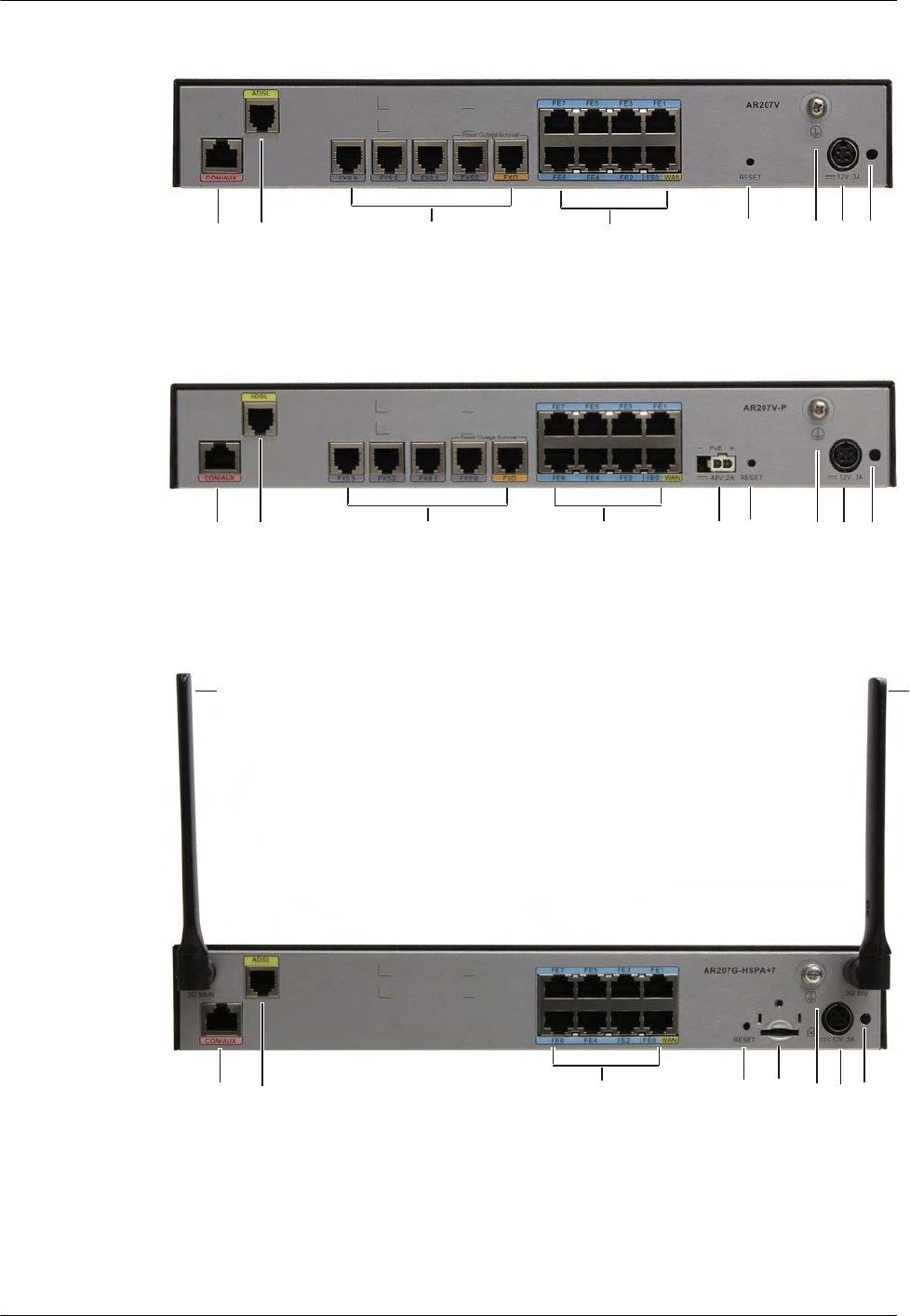
Figure 4-15 AR207V rear view
7
12356
4
9
Figure 4-16 AR207V-P rear view
7
12356
49 10
Figure 4-17 AR207G-HSPA+7 rear view
7356
4
1211
12 12
Huawei AR G3 Series Enterprise Routers
Product Description 4 Device Structure of AR150 and AR200 Series
Issue 02 (2012-04-20) Huawei Proprietary and Confidential
Copyright © Huawei Technologies Co., Ltd.
35
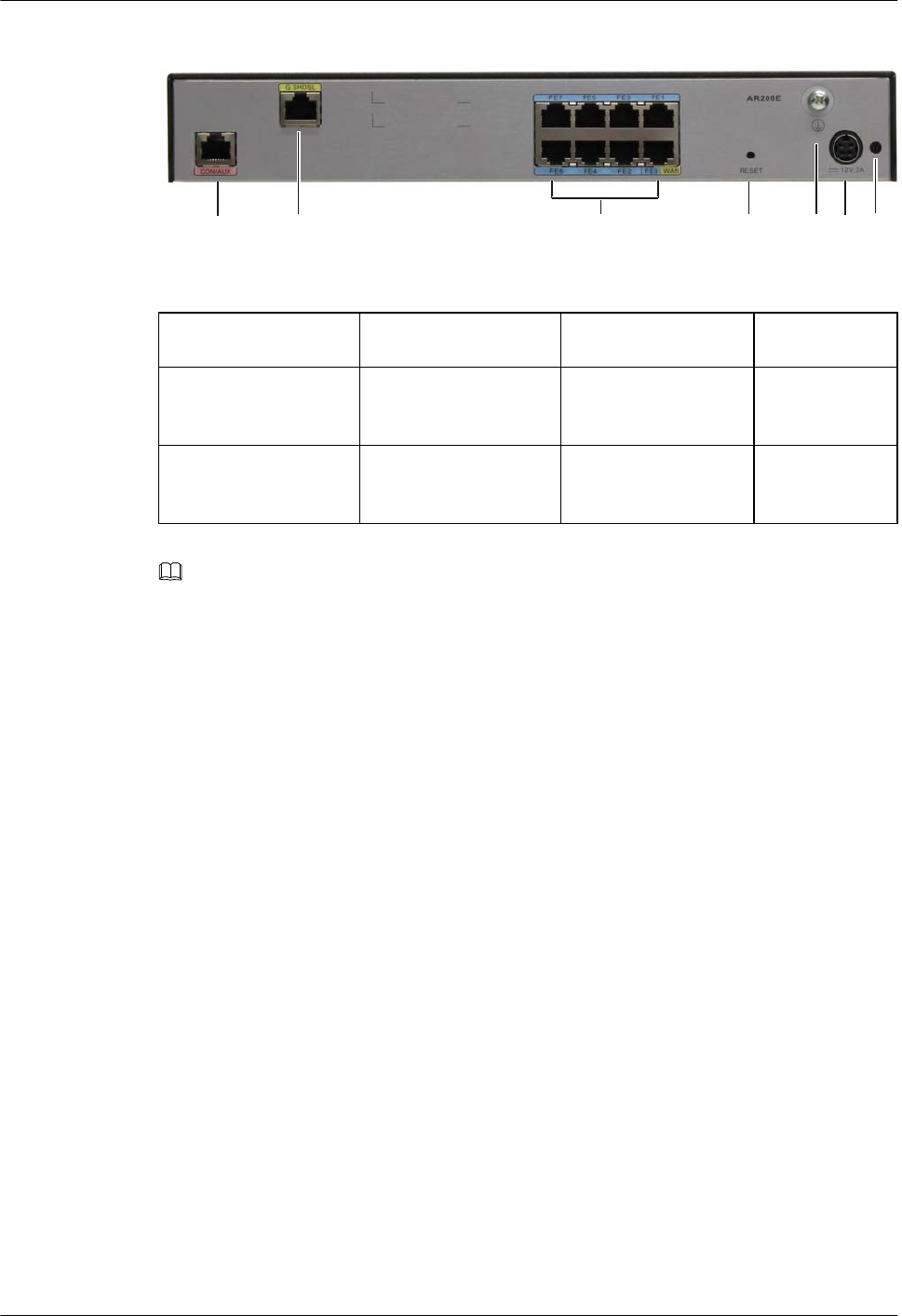
Figure 4-18 AR208E rear view
71 23 5 6
4
1. CON/AUX interface 2. Fixed FE interfaces 3. RESET Button 4. Ground screw
5. AC jack 6. Access hole for the
power cable
7. WAN-side uplink
interface
8. USB interface
9. 4FXO/1FXS
interfaces
10. PoE port 11. SIM card slot 12. 3G antenna
NOTE
lThe AR200 provides eight LAN-side FE interfaces. The FE0 interface can be configured as a WAN-
side Layer 3 interface.
lOn the AR201, FE interfaces are WAN-side interfaces. On the AR206, ADSL ANNEX B interfaces
are WAN-side interfaces. On the AR207, AR207V, AR207V-P, and AR207G-HSPA+7, ADSL
ANNEX A/M interfaces are WAN-side interfaces. On the AR208E, 4-channel G.SHDSL interfaces
are WAN-side interfaces.
Huawei AR G3 Series Enterprise Routers
Product Description 4 Device Structure of AR150 and AR200 Series
Issue 02 (2012-04-20) Huawei Proprietary and Confidential
Copyright © Huawei Technologies Co., Ltd.
36
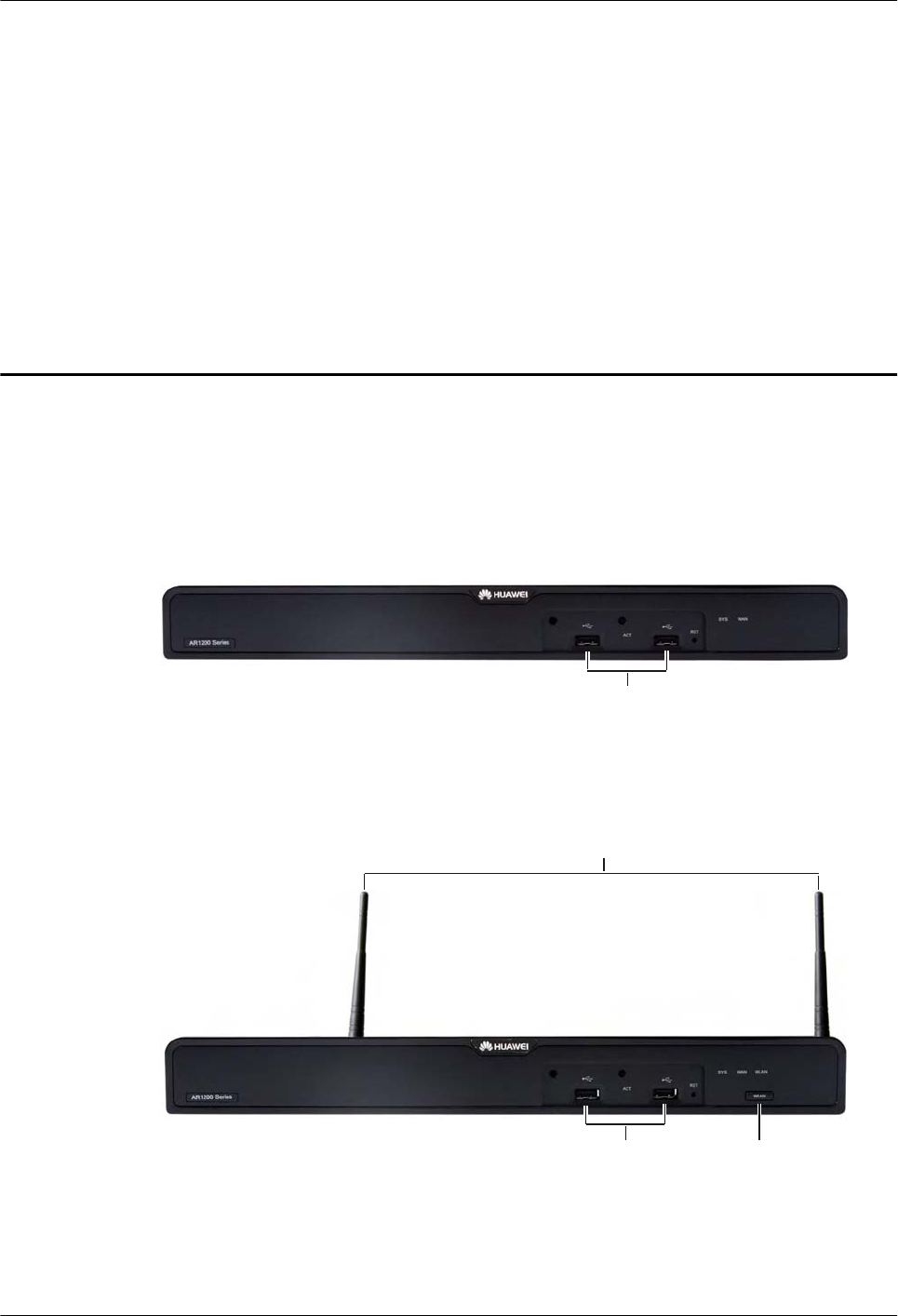
5 Device Structure of AR1200, AR2200 and
AR3200 Series
Appearance
Figure 5-1 and Figure 5-2 show the front view of AR1200 series.
Figure 5-1 AR1220/AR1220V/AR1220L front view
18
Figure 5-2 AR1220W/AR1220VW front view
2018
19
Figure 5-3, Figure 5-4, Figure 5-5, Figure 5-6, and Figure 5-7 show rear views of AR1200
series.
Huawei AR G3 Series Enterprise Routers
Product Description 5 Device Structure of AR1200, AR2200 and AR3200 Series
Issue 02 (2012-04-20) Huawei Proprietary and Confidential
Copyright © Huawei Technologies Co., Ltd.
37
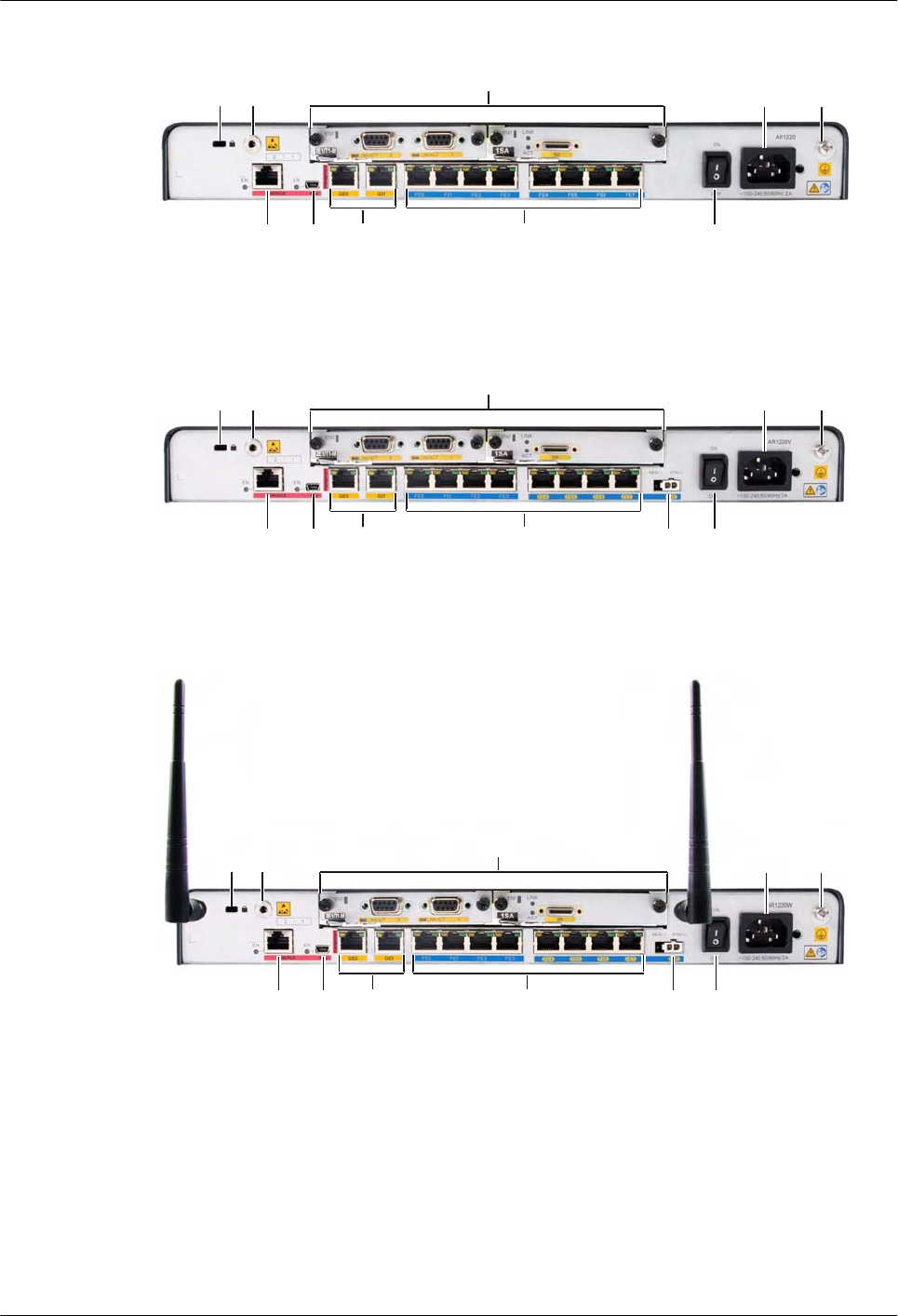
Figure 5-3 AR1220 rear view
2 4 3
1
7
1012131415
Figure 5-4 AR1220V rear view
2 4 3
1
7
101213 111415
Figure 5-5 AR1220W rear view
24 3
1
7
101213 111415
Huawei AR G3 Series Enterprise Routers
Product Description 5 Device Structure of AR1200, AR2200 and AR3200 Series
Issue 02 (2012-04-20) Huawei Proprietary and Confidential
Copyright © Huawei Technologies Co., Ltd.
38
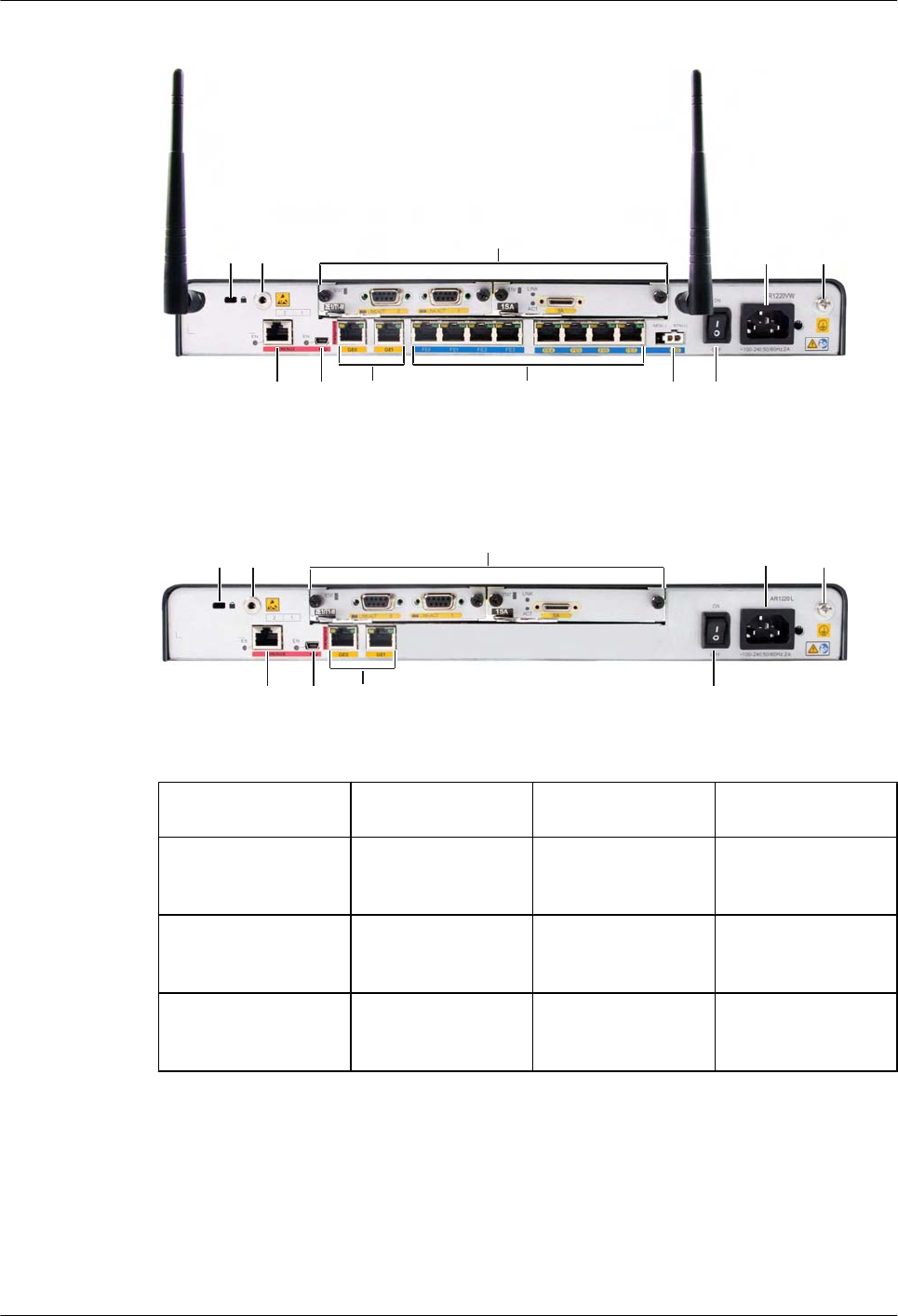
Figure 5-6 AR1220VW rear view
2 4 3
1
7
101213 111415
Figure 5-7 AR1220L rear view
243
1
7
10131415
1. Pluggable card 2. ESD jack 3. Ground screw 4. AC jack
7. Security lock 10. AC power switch 11. PoE port 12. Fixed 8FE
interface on the panel
13. Two Fixed GE
interfaces on the panel
14. Mini USB
interface
15. CON/AUX
interface
18. USB interface
19. Antenna 20. WLAN switch
button
Figure 5-8 and Figure 5-9 show front views of AR2200 series.
Huawei AR G3 Series Enterprise Routers
Product Description 5 Device Structure of AR1200, AR2200 and AR3200 Series
Issue 02 (2012-04-20) Huawei Proprietary and Confidential
Copyright © Huawei Technologies Co., Ltd.
39
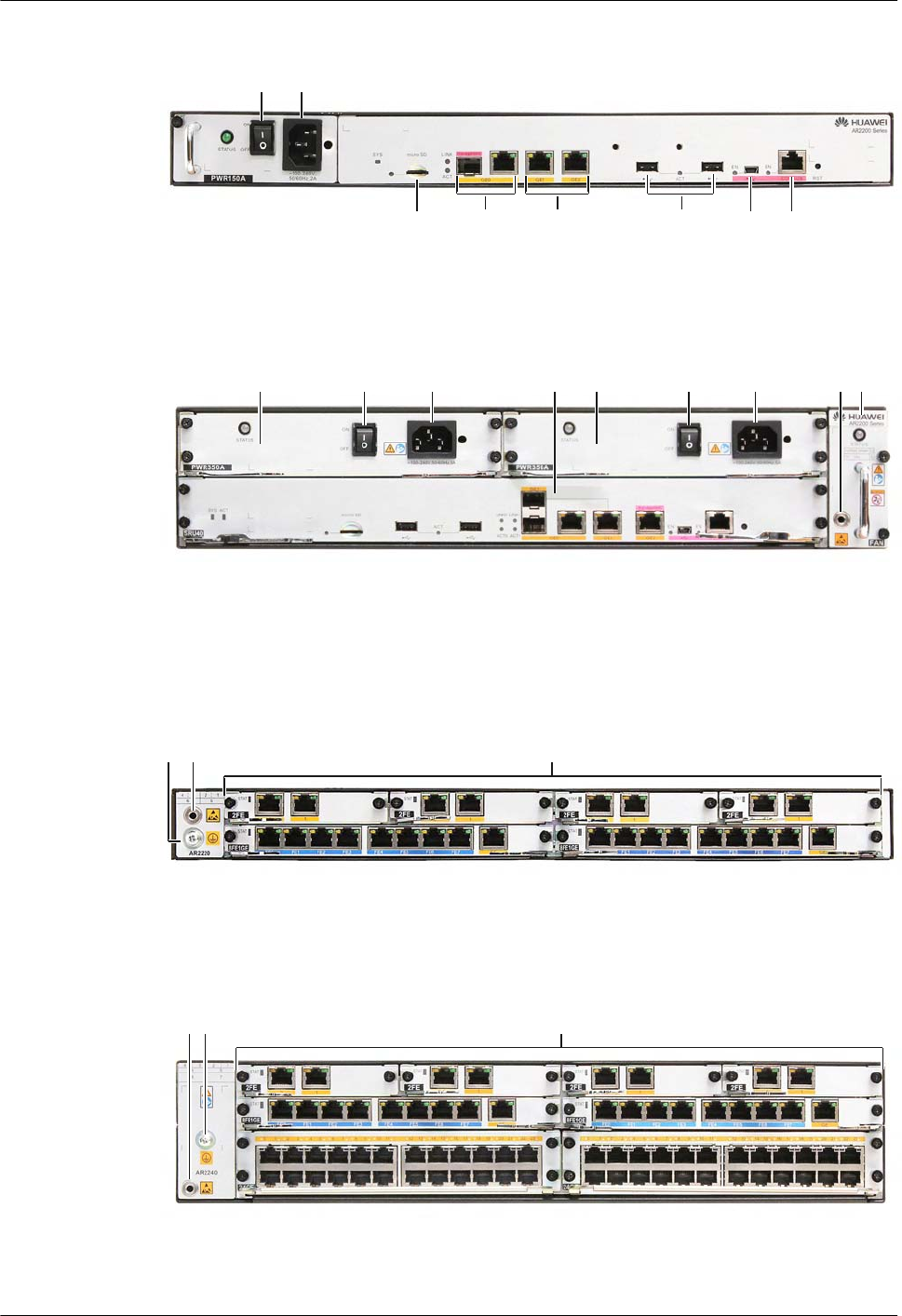
Figure 5-8 AR2220 front view
410
14 151317 1816
Figure 5-9 AR2240 front view
24 410 89106 6
Figure 5-10 and Figure 5-11 show rear views of AR2200 series.
Figure 5-10 AR2220 rear view
123
Figure 5-11 AR2240 rear view
12 3
Huawei AR G3 Series Enterprise Routers
Product Description 5 Device Structure of AR1200, AR2200 and AR3200 Series
Issue 02 (2012-04-20) Huawei Proprietary and Confidential
Copyright © Huawei Technologies Co., Ltd.
40
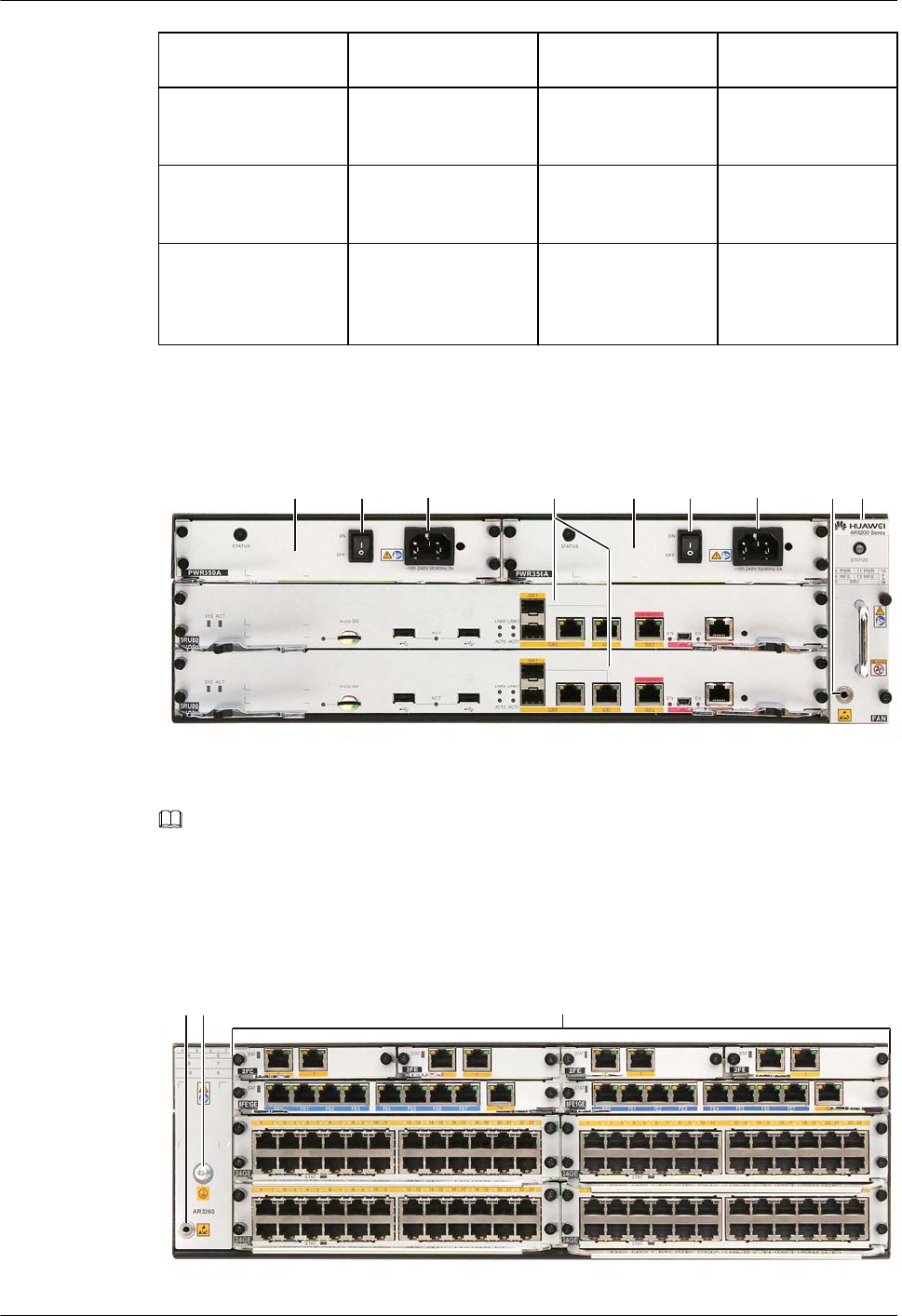
1. Pluggable card 2. ESD jack 3. Ground screw 4. AC jack
6. Pluggable AC
power supply unit
8. Pluggable fan
module
9. SRU 10. AC power switch
13. Two Fixed GE
interfaces on the panel
14. Mini USB
interface
15. CON/AUX
interface
16. Micro SD card
interface
17. GE optical/
electrical Combo
interface
18. USB interfaces
Figure 5-12 shows the front view of AR3260.
Figure 5-12 AR3260 front view
24 410 89106 6
NOTE
The AR3260 supports only one SRU, which can be installed in slot 15. It will support double SRUs in later
versions.
Figure 5-13 shows the rear view of AR.
Figure 5-13 AR3260 rear view
12 3
Huawei AR G3 Series Enterprise Routers
Product Description 5 Device Structure of AR1200, AR2200 and AR3200 Series
Issue 02 (2012-04-20) Huawei Proprietary and Confidential
Copyright © Huawei Technologies Co., Ltd.
41

1. Pluggable card 2. ESD jack 3. Ground screw 4. AC jack
6. Pluggable AC power
supply unit
8. Pluggable fan module 9. SRU 10. AC power switch
Slot distribution
Figure 5-14, Figure 5-15 and Figure 5-16 show slot distribution on AR.
NOTE
lAfter two slots are combined into one, the slot ID is the larger one between the original two slots.
Figure 5-14 Slot distribution on AR1200
Front
view
Rear
view
Device Model Slot Distribution
AR1200
NA
Two SIC slots are combined into
one WSIC slot
NA
1(SIC)2(SIC)
0(SRU)
Slot Combination
2(WSIC)
0(SRU)
Huawei AR G3 Series Enterprise Routers
Product Description 5 Device Structure of AR1200, AR2200 and AR3200 Series
Issue 02 (2012-04-20) Huawei Proprietary and Confidential
Copyright © Huawei Technologies Co., Ltd.
42
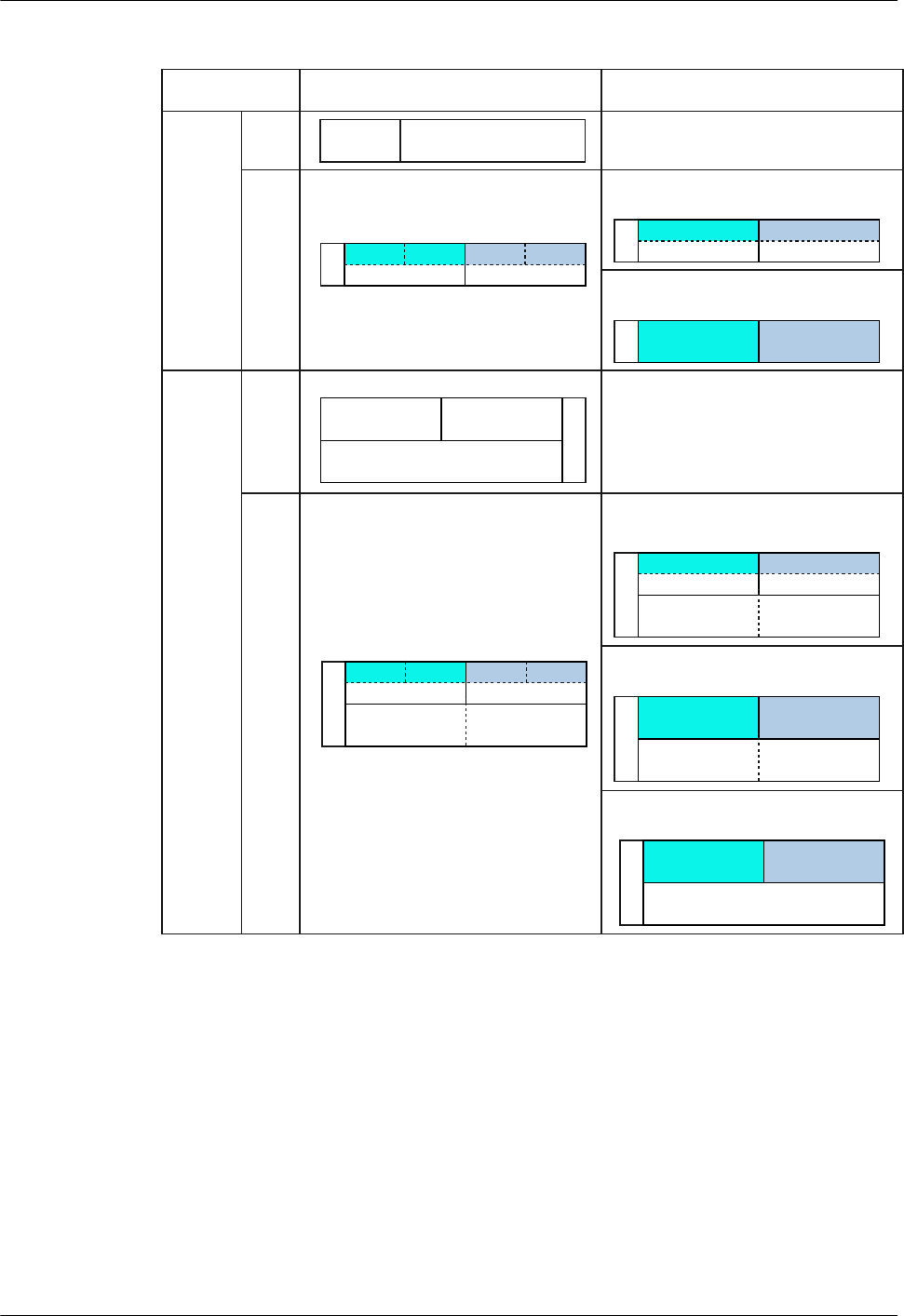
Figure 5-15 Slot distribution on AR2200
AR2220
AR2240
NA
0(SRU)7(Power)
9(Power)10(Power)
11(SRU)
F
A
N
NA
2(SIC)3(SIC)4(SIC)
5(WSIC)6(WSIC)
7(XSIC)8(XSIC)
1(SIC)
2(WSIC)4(WSIC)
5(WSIC)6(WSIC)
7(XSIC)8(XSIC)
5(XSIC)6(XSIC)
7(XSIC)8(XSIC)
Front
view
Rear
view
Device Model Slot Distribution
Two SIC slots are combined into
one WSIC slot
Slot Combination
Front
view
Rear
view
Two WSIC slots are combined
into one XSIC slot
Two SIC slots are combined into
one WSIC slot
Two WSIC slots are combined
into one XSIC slot
Two XSIC slots are combined
into one EXSIC slot
5(XSIC)6(XSIC)
2(WSIC)4(WSIC)
5(WSIC)6(WSIC)
2(SIC)3(SIC)4(SIC)
5(WSIC)6(WSIC)
1(SIC)
5(XSIC)6(XSIC)
8(EXSIC)
Huawei AR G3 Series Enterprise Routers
Product Description 5 Device Structure of AR1200, AR2200 and AR3200 Series
Issue 02 (2012-04-20) Huawei Proprietary and Confidential
Copyright © Huawei Technologies Co., Ltd.
43
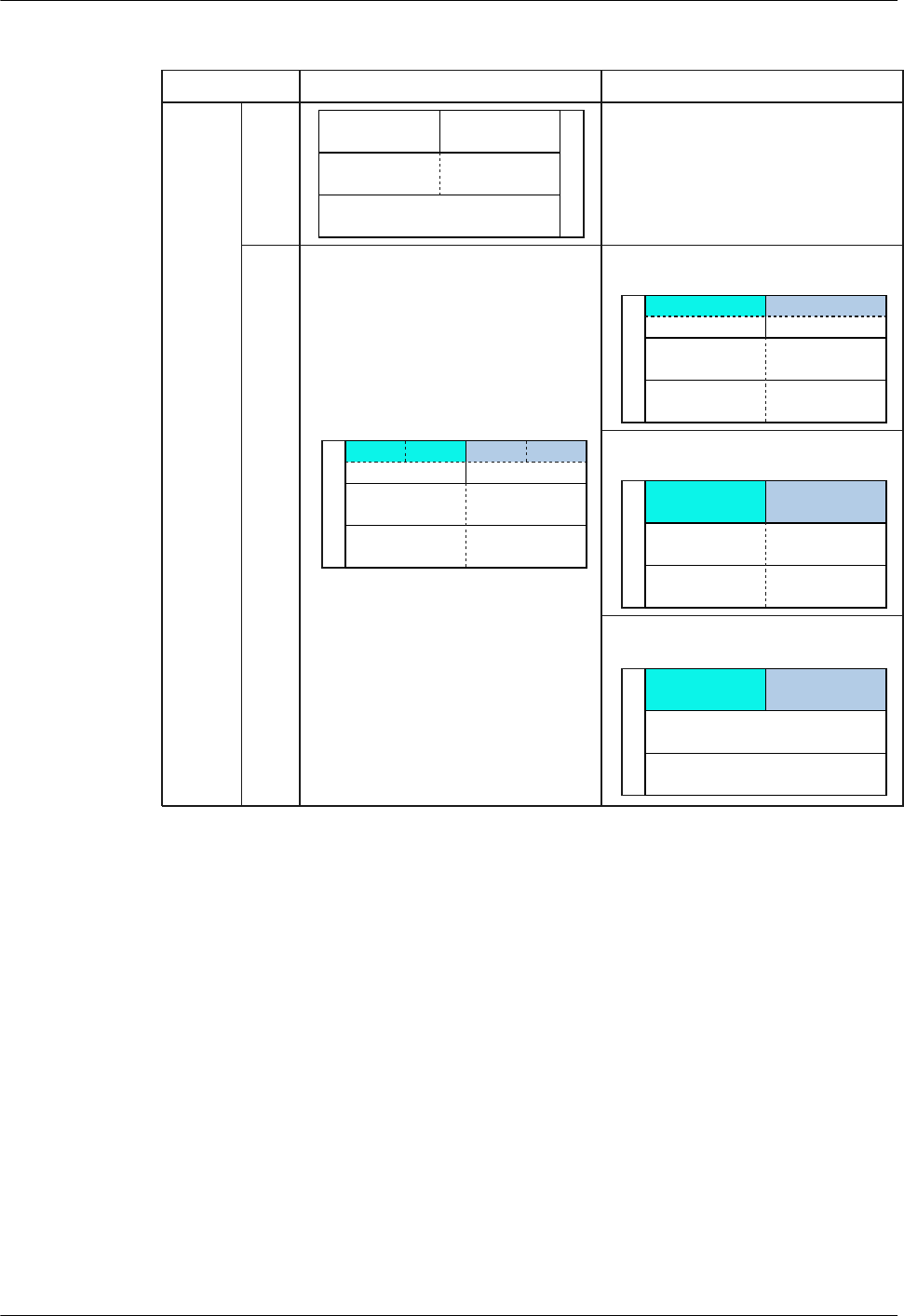
Figure 5-16 Slot distribution on AR3200
AR3260
2(SIC)3(SIC)4(SIC)
5(WSIC)6(WSIC)
7(XSIC)8(XSIC)
9(XSIC)10(XSIC)
1(SIC)
2(WSIC)4(WSIC)
5(WSIC)6(WSIC)
7(XSIC)8(XSIC)
9(XSIC)10(XSIC)
5(XSIC)6(XSIC)
7(XSIC)8(XSIC)
9(XSIC)10(XSIC)
Front
view
Rear
view
Device Model Slot Distribution Slot Combination
Two SIC slots are combined into
one WSIC slot
Two WSIC slots are combined
into one XSIC slot
Two XSIC slots are combined
into one EXSIC slot
5(XSIC)6(XSIC)
8(EXSIC)
10(EXSIC)
Insert the SRU into slot 15.
15(SRU)
14(MFS)
11(Power)
12(Power)
F
A
N
13(MFS)
As shown in Figure 5-14, Figure 5-15 and Figure 5-16, the slots of AR can be combined.
lAR1200 Series
–Slot 1 and slot 2 are combined into new slot 2.
lAR2220
–Slot 1 and slot 2 are combined into new slot 2.
–Slot 3 and slot 4 are combined into new slot 4.
–New slot 2 and slot 5 are combined into new slot 5.
–New slot 4 and slot 6 are combined into new slot 6.
lAR2240
–Slot 1 and slot 2 are combined into new slot 2.
–Slot 3 and slot 4 are combined into new slot 4.
–New slot 2 and slot 5 are combined into new slot 5.
Huawei AR G3 Series Enterprise Routers
Product Description 5 Device Structure of AR1200, AR2200 and AR3200 Series
Issue 02 (2012-04-20) Huawei Proprietary and Confidential
Copyright © Huawei Technologies Co., Ltd.
44

–New slot 4 and slot 6 are combined into new slot 6.
–Slot 7 and slot 8 are combined into new slot 8.
lAR3260
–Slot 1 and slot 2 are combined into new slot 2.
–Slot 3 and slot 4 are combined into new slot 4.
–New slot 2 and slot 5 are combined into new slot 5.
–New slot 4 and slot 6 are combined into new slot 6.
–Slot 7 and slot 8 are combined into new slot 8.
–Slot 9 and slot 10 are combined into new slot 10.
–Slots 13 and 14 are multiple function slots. They can be combined into new slot 14,
which is reserved for the slave main control board.
Huawei AR G3 Series Enterprise Routers
Product Description 5 Device Structure of AR1200, AR2200 and AR3200 Series
Issue 02 (2012-04-20) Huawei Proprietary and Confidential
Copyright © Huawei Technologies Co., Ltd.
45

6.1 Various Maintenance Methods
The ARs support various local and remote maintenance methods:
lLocal maintenance using the console interface
lLocal or remote maintenance using Telnet
lSecure shell (SSH) maintenance: guarantees security and provides authentication for login
users on an insecure network, and defends against various attacks, including IP address
spoofing, plain text password interception, and denial of service (DoS).
6.1.1 Web-based Network Management System
The ARs support the web-based network management system, which provides GUI for device
configuration and management.
Users can use the web-based system to manage network devices on the GUI. A junior engineer
can use the GUI easily.
6.1.2 CWMP
The CPE WAN Management Protocol (CWMP) is drafted by the Digital Subscriber's Line (DSL)
forum. It is also called TR-069 standard. CWMP standardizes the communication between
customer premises equipment (CPE) and auto-configuration server (ACS).
There are a lot of user devices separated on the access network. They are difficult to manage
and maintain. The ARs are the CPE deployed at the user network side. The ACS uses CWMP
to remotely manage the CPE. This reduces maintenance cost and improves troubleshooting
efficiency.
6.1.3 Remote Deployment and Maintenance Using USB
As the network expands, more and more network devices are used and software commissioning
costs increase. USB-based deployment does not require software commissioning, which reduces
deployment costs.
Before using a USB flash drive to configure an AR, store software package and configuration
files on the USB flash drive. Software engineers do not need to commission devices onsite. After
installing the AR, hardware engineers will insert the USB flash drive into the USB interface on
the AR and power on the AR. After being started, the AR automatically loads and upgrades the
software.
6.1.4 SNMP-based Maintenance
The ARs support the Simple Network Management Protocol (SNMP) v1/v2c/v3 and the Client/
Server model. The ARs can be managed by the network management system (NMS), such as
iManager U2000.
6.2 Fault Location
Huawei AR G3 Series Enterprise Routers
Product Description 6 Maintenance and Management
Issue 02 (2012-04-20) Huawei Proprietary and Confidential
Copyright © Huawei Technologies Co., Ltd.
47

6.2.1 Device Fault Location
The ARs support the following functions to locate device faults:
lLog
After detecting a service error or recovery event, the AR logs the event and sends the
information to the background server.
lFast information collection
A system administrator can use display diagnostic-information to collect device fault
information.
lDevice monitoring
The AR can monitor all the key indexes and components such as voltage, temperature, fan,
and power supply unit. In addition, the AR can send a trap if an error occurs.
6.2.2 Service Fault Location
The ARs support the following functions to locate service faults:
lLocating Ethernet interface faults
The ARs support interface status display, line tests, and loopback tests on interfaces. The
ARs test packet sending and receiving on interfaces and collect packet statistics, assisting
administrators to locate network faults and Ethernet interface connection faults.
lNetwork-side interface faults
The ARs support WAN interface tests, which collect traffic statistics and event statistics
on WAN interfaces and perform tests such as ATM, OAM, and interface loopback.
lPort mirroring and traffic mirroring
The ARs support packet mirroring on Ethernet interfaces, mirroring of packets from a
network-side interface to a user-side Ethernet interface, and mirroring of protocol packets
sent to the CPU.
lConnection fault
The ARs test connections and display connection status on network-side interfaces, and
collect connection statistics.
lVoice signal fault
The ARs record the entire signal interaction process and test signal online. In addition, the
ARs test the quality of VoIP services and locate dialing and service faults.
Huawei AR G3 Series Enterprise Routers
Product Description 6 Maintenance and Management
Issue 02 (2012-04-20) Huawei Proprietary and Confidential
Copyright © Huawei Technologies Co., Ltd.
48

7.1 System Configuration
Table 7-1 System configuration
Model Processor Memory Flash
Memory
Micro SD Card
(built-in)
AR151 Dual-core, 533
MHz
512 MB 512 MB 0
AR157 Dual-core, 533
MHz
512 MB 512 MB 0
AR201 Dual-core, 533
MHz
512 MB 512 MB 0
AR206 Dual-core, 533
MHz
512 MB 512 MB 0
AR207 Dual-core, 533
MHz
512 MB 512 MB 0
AR207V Dual-core, 533
MHz
512 MB 512 MB 0
AR207V-P Dual-core, 533
MHz
512 MB 512 MB 0
AR207G-
HSPA+7
Dual-core, 500
MHz
512M 512M 0
AR208 Dual-core, 533
MHz
512 MB 512 MB 0
AR1220 Dual-core, 500
MHz
512 MB 256 MB 0
AR1220V Dual-core, 500
MHz
512 MB 256 MB 0
AR1220W Dual-core, 500
MHz
512 MB 256 MB 0
AR1220VW Dual-core, 500
MHz
512 MB 256 MB 0
AR1220L Dual-core, 500
MHz
512M 256M 0
AR2220 4-core 600 MHz 2 GB 16 MB 2 GB
AR2240 8-core 600 MHz 2 GB 16 MB 2 GB
AR3260 12-core 750
MHz
2 GB 16 MB 2 GB
Huawei AR G3 Series Enterprise Routers
Product Description 7 System Parameters
Issue 02 (2012-04-20) Huawei Proprietary and Confidential
Copyright © Huawei Technologies Co., Ltd.
50

7.2 Physical Specifications
Table 7-2 Physical specifications
Item Description
Dimensions (H x W x D) lWithout rack-mounting ear
–AR150 series: 44 mm x 300 mm x 216.4 mm (1.73in.
x 11.81in. x 8.52in.)
–AR200 series: 44 mm x 300 mm x 216.4 mm (1.73in.
x 11.81in. x 8.52in.)
–AR1200 series: 44.5mm x 390.0 mm x 220.0 mm
(1.75in. x 15.35in. x 8.66in.)
–AR2220: 44.5mm x 442.0 mm x 420.0 mm (1.75 in.
x 17.4 in. x 16.54 in.)
–AR2240: 88.1 mm x 442.0 mm x 470.0 mm (3.47 in.
x 17.4 in. x 18.5 in.)
–AR3260: 130.5 mm x 442.0 mm x 470.0 mm (5.14
in. x 17.4 in. x 18.5 in.)
lWith rack-mounting ear
–AR150 series: 44 mm x 482.6 mm x 216.4 mm
(1.73in. x 19in. x 8.52in.)
–AR200 series: (1.73in. x 19in. x 8.52in.)
–AR1200 series: 44.5 mm x 482.6 mm x 220.0 mm
(1.75 in. x 19 in. x 8.66 in.)
–AR2220: 44.5 mm x 482.6 mm x 420.0 mm (1.75 in.
x 19 in. x 16.54 in.)
–AR2240: 88.1 mm x 482.6 mm x 470.0 mm (3.47 in.
x 19 in. x 18.5 in.)
–AR3260: 130.5 mm x 482.6 mm x 470.0 mm (5.14
in. x 19 in. x 18.5 in.)
Huawei AR G3 Series Enterprise Routers
Product Description 7 System Parameters
Issue 02 (2012-04-20) Huawei Proprietary and Confidential
Copyright © Huawei Technologies Co., Ltd.
51

Item Description
Maximum power consumption
(empty chassis)
lAR151: 11.4W
lAR157: 14.5W
lAR201: 12.5W
lAR206: 14.6W
lAR207: 15.6W
lAR207V: 22.3W
lAR207V-P: 22.3W
lAR208E: 14.2W
lAR207G-HSPA+7: 17.1W
lAR1200 series: 33.3 W
lAR2220: 65.1W
lAR2240: 114.9W
lAR3260: 163.2W
Weight Full
configuration
lAR150 and AR200 series: 2.20kg
lAR1200 series: 3.60 kg (7.94 lb)
lAR2220: 8.45 kg (18.63 lb)
lAR2240: 19.30 kg (42.56 lb)
lAR3260: 25.65 kg (56.56 lb)
Empty chassis lAR150 and AR200 series: 2.20kg
lAR1200 series: 2.90 kg (6.39 lb)
lAR2220: 4.95 kg (10.91 lb)
lAR2240: 8.85 kg (19.51 lb)
lAR3260: 11.00 kg (24.26 lb)
DC input
voltage
(AR2200 and
AR3200
Series)
Rated voltage -48 V DC to -60 V DC
Voltage range -38.4 V DC to -72 V DC
DC input
voltage
(AR150 and
AR200
Series)
Rated voltage 12V DC
AC input
voltage
Rated voltage 100 V AC to 240 V AC
Voltage range AR1200/AR2200/AR3200 series: 85 V AC to 264 V AC
AR150/AR200 Series: 90 V AC to 264 V AC
Operating temperature 0 °C to 40 °C (0 °F to 104 °F)
Relative humidity 5% RH to 90% RH
Huawei AR G3 Series Enterprise Routers
Product Description 7 System Parameters
Issue 02 (2012-04-20) Huawei Proprietary and Confidential
Copyright © Huawei Technologies Co., Ltd.
52

Item Description
Altitude Long-term
altitude
lAR1200/AR2200/AR3200 series: Lower than 4000 m
(13123.2 ft.)
lAR150/AR200 series: Lower than 3000 m (9842.4 ft.)
Storage
altitude
Lower than 4000 m (13123.2 ft.)
Huawei AR G3 Series Enterprise Routers
Product Description 7 System Parameters
Issue 02 (2012-04-20) Huawei Proprietary and Confidential
Copyright © Huawei Technologies Co., Ltd.
53

8.1 Router Purchase List
Table 8-1 Purchase list of AR150 series
Component Typical Configuration Remarks
AR151 Basic configuration of the AR151, including the AR201
assembly chassis, and basic software package
Mandatory
AR157 Basic configuration of the AR157, including the AR207
assembly chassis, and basic software package
Mandatory
Table 8-2 Purchase list of AR200 series
Component Typical Configuration Remarks
AR201 Basic configuration of the AR201, including the AR201
assembly chassis, and basic software package
Mandatory
AR206 Basic configuration of the AR206, including the AR206
assembly chassis, and basic software package
Mandatory
AR207 Basic configuration of the AR207, including the AR207
assembly chassis, and basic software package
Mandatory
AR207V Basic configuration of the AR207V, including the
AR207L assembly chassis, and basic software package
Mandatory
AR207V-P Basic configuration of the AR207V-P, including the
AR207V-P assembly chassis, 100 W PoE power supply
adapter module, and basic software package
Mandatory
AR208E Basic configuration of the AR208E, including the
AR208E assembly chassis, and basic software package
Mandatory
AR207G-
HSPA+7
Basic configuration of the AR207G-HSPA+7,
including the AR207G-HSPA+7 assembly chassis, and
basic software package
Mandatory
3G extended
antenna
Omni antenna Optional
NOTE
Only the
AR207G-HSPA
+7 can be
configured with
the Omni antenna.
Huawei AR G3 Series Enterprise Routers
Product Description 8 Component Selection Guide
Issue 02 (2012-04-20) Huawei Proprietary and Confidential
Copyright © Huawei Technologies Co., Ltd.
55

Table 8-3 Purchase list of AR1200 series
Component Typical Configuration Remarks
AR1220 Basic configuration of AR1220, including AR1220
assembly chassis, and basic software package
Mandatory
AR1220V AR1220 with the voice function, including AR1220
assembly chassis, 32-channel digital signal processor
(DSP), and basic software package
Mandatory
AR1220W AR1220 with the WLAN functions, including AR1220
assembly chassis, 802.11b/g/n AP, and basic software
package
Mandatory
AR1220VW AR1220 with the voice and WLAN functions, including
AR1220 assembly chassis, 16-channel DSP, 802.11b/
g/n AP, and basic software package
Mandatory
AR1220L Basic configuration of AR1220L, including AR1220L
assembly chassis and basic software package
Mandatory
PoE power
supply unit
100 W PoE power supply adapter module Optional
NOTE
Only applied to
AR1220V,
AR1220VW, and
AR1220W.
Table 8-4 Purchase list of AR2220
Component Typical Configuration Remarks
AR2220 Basic configuration of AR2220 with AC power,
including AR2220 assembly chassis, 150 W AC power
supply, and basic software package
Basic configuration of AR2220 with DC power,
including AR2220 assembly chassis, 150 W DC power
supply, and basic software package
Mandatory
DSP module 16/32/64/128-channel voice DSP module Optional
Huawei AR G3 Series Enterprise Routers
Product Description 8 Component Selection Guide
Issue 02 (2012-04-20) Huawei Proprietary and Confidential
Copyright © Huawei Technologies Co., Ltd.
56

Table 8-5 Purchase list of AR2240
Component Typical Configuration Remarks
AR2240 lBasic configuration of AR2240 with standard main
control board and AC power supply, including
AR2240 assembly chassis, 350 W AC power supply,
standard main control board, and basic software
package
lBasic configuration of AR2240 with standard main
control board and DC power supply, including
AR2240 assembly chassis, 350 W DC power supply,
standard main control board, and basic software
package
lBasic configuration of AR2240 with enhanced main
control board and AC power supply, including
AR2240 assembly chassis, 350 W AC power supply,
enhanced main control board, and basic software
package
lBasic configuration of AR2240 with enhanced main
control board and DC power supply, including
AR2240 assembly chassis, 350 W DC power supply,
standard main control board, and basic software
package
Mandatory
Fan AR2240 Fan module Mandatory
AC power
supply unit
350 W AC power supply unit Optional. By
default, a router
has one AC power
supply unit. To
perform load
balancing, two
AC power supply
units can be
installed.
DC power
supply unit
350 W DC power supply unit Optional. By
default, a DC
router has one DC
power supply
unit. To perform
load balancing,
two DC power
supply units can
be installed.
DSP module 16/32/64/128-channel voice DSP module Optional
Huawei AR G3 Series Enterprise Routers
Product Description 8 Component Selection Guide
Issue 02 (2012-04-20) Huawei Proprietary and Confidential
Copyright © Huawei Technologies Co., Ltd.
57

Table 8-6 Purchase list of AR3260
Component Typical Configuration Remarks
AR3260 lBasic configuration of AR3260 with enhanced main
control board and AC power supply, including
AR3260 assembly chassis, 350 W AC power supply,
enhanced main control board, and basic software
package
lBasic configuration of AR3260 with standard main
control board and AC power supply, including
AR3260 assembly chassis, 350 W AC power supply,
standard main control board, and basic software
package
lBasic configuration of AR3260 with standard main
control board and DC power supply, including
AR3260 assembly chassis, 350 W DC power supply,
standard main control board, and basic software
package
lBasic configuration of AR3260 with enhanced main
control board and DC power supply, including
AR3260 assembly chassis, 350 W DC power supply,
enhanced main control board, and basic software
package
Mandatory
Fan AR3260 fan module Mandatory
AC power
supply unit
350 W AC power supply unit Optional. By
default, an AC
router has one AC
power supply
unit. To perform
load balancing,
two AC power
supply units can
be installed.
DC power
supply unit
350 W DC power supply unit Optional. By
default, a DC
router has one DC
power supply
unit. To perform
load balancing,
two DC power
supply units can
be installed.
DSP module 16/32/64/128-channel voice DSP module Optional
Huawei AR G3 Series Enterprise Routers
Product Description 8 Component Selection Guide
Issue 02 (2012-04-20) Huawei Proprietary and Confidential
Copyright © Huawei Technologies Co., Ltd.
58

8.2 Board Purchase List
NOTE
An AR150 router or AR200 router has no slot; therefore, you do not need to purchase the following boards
for the AR200.
Table 8-7 Board purchase list
Silkscreen Description
8FE1GE 9-port 8FE/1GE L2/L3 Ethernet interface card
24GE 24-port GE L2/L3 Ethernet interface card
1GEC 1-port GE combo WAN interface card
2FE 2-port FE WAN interface card
4GEW-T 4-port GE optical port WAN interface card
4GEW-S 4-port GE electrical port WAN interface card
1E1/T1-M 1-port channelized E1/PRI/VE1; MFT: Multiflex Trunk
1E1/T1-F 1-port unchannelized E1/unstructure E1/fractional E1,120
ohm WAN interface card
2E1/T1-F 2-port unchannelized E1/unstructure E1/fractional E1,120
ohm WAN interface card
2E1/T1-M 2-port channelized E1/PRI/VE1; MFT: Multiflex Trunk,
including SIC and WSIC
1SA 1-port sync/async serial WAN interface card
2SA 2-port sync/async serial WAN interface card
1BST 1-port ISDN S/T WAN interface card
2BST 2-port ISDN S/T voice interface card, including SIC and
WSIC
4FXS1FXO 5-port 4FXS/1FXO voice interface card
1ADSL-A/M 1-port ADSL2+ annex A/M WAN interface card
1ADSL-B 1-port ADSL2+ annex B WAN interface card
VDSL 1-port VDSL2 over POTS WAN interface card
4G.SHDSL 4-pair G.SHDSL WAN interface card
1CPOS-155M 1-Port Channelized Packet over SDH/Sonet interface card
NOTE
The AR1200 does not support 1CPOS-155M.
1PON 1-port-xPON WAN interface card
Huawei AR G3 Series Enterprise Routers
Product Description 8 Component Selection Guide
Issue 02 (2012-04-20) Huawei Proprietary and Confidential
Copyright © Huawei Technologies Co., Ltd.
59

Silkscreen Description
3G-HSPA+7 3G WAN interface card
- 16/32/64/128-channel DSP module
Huawei AR G3 Series Enterprise Routers
Product Description 8 Component Selection Guide
Issue 02 (2012-04-20) Huawei Proprietary and Confidential
Copyright © Huawei Technologies Co., Ltd.
60



